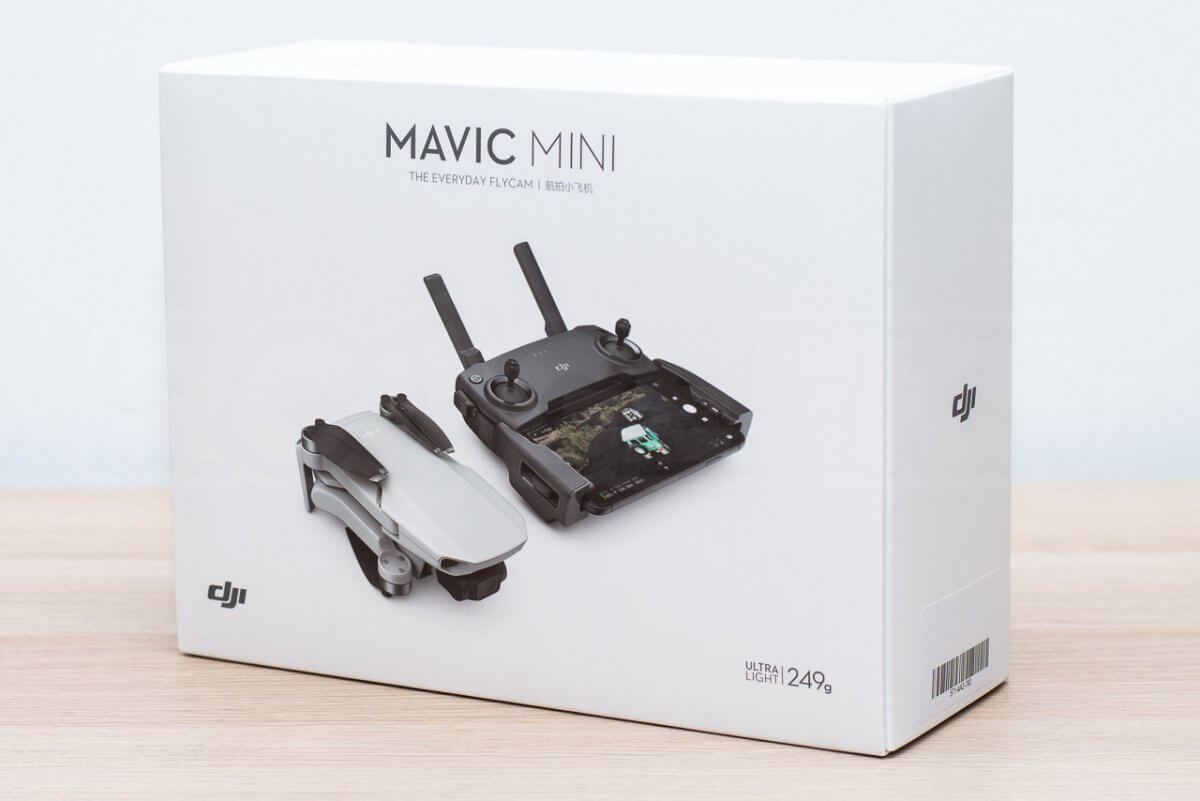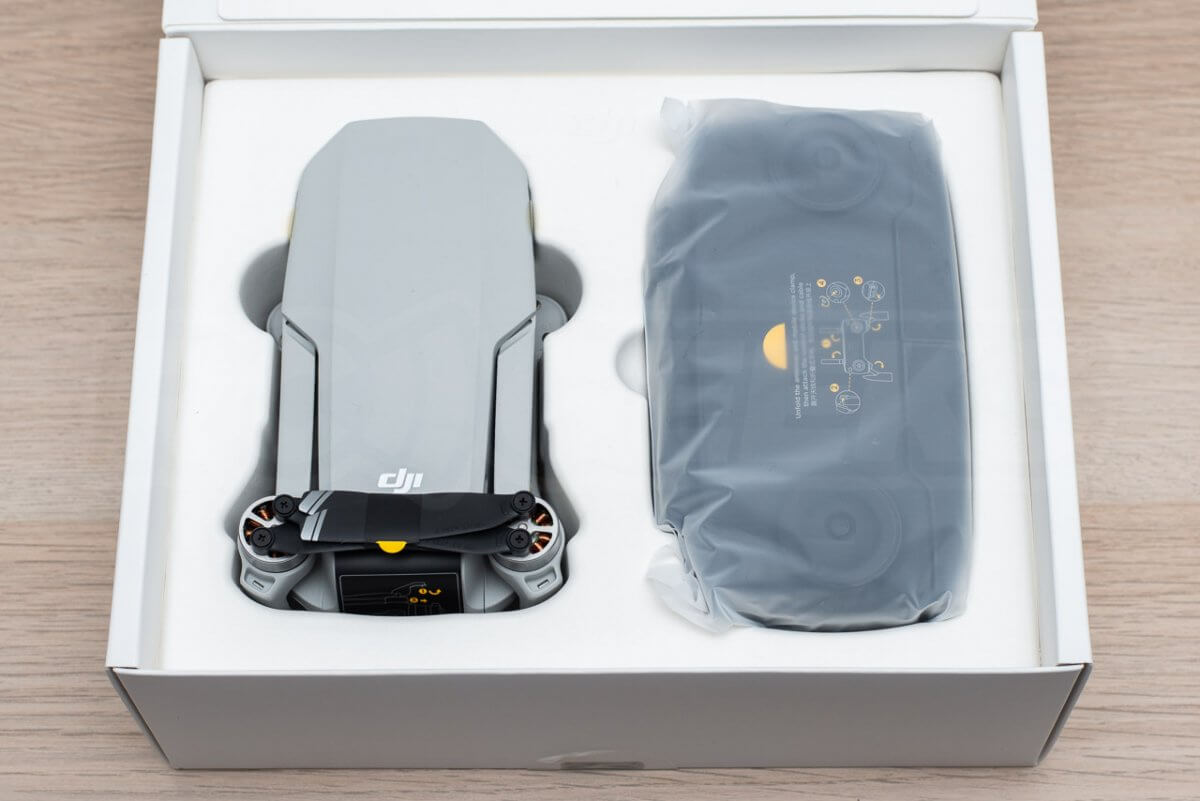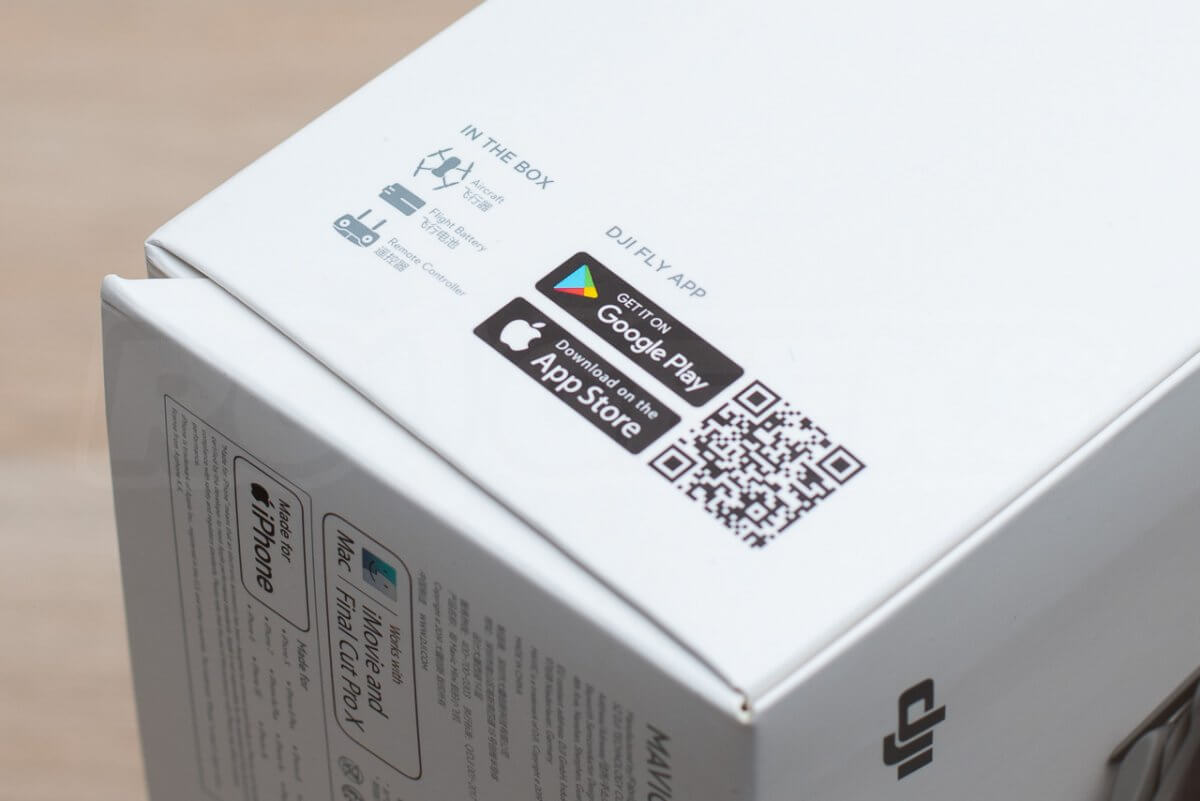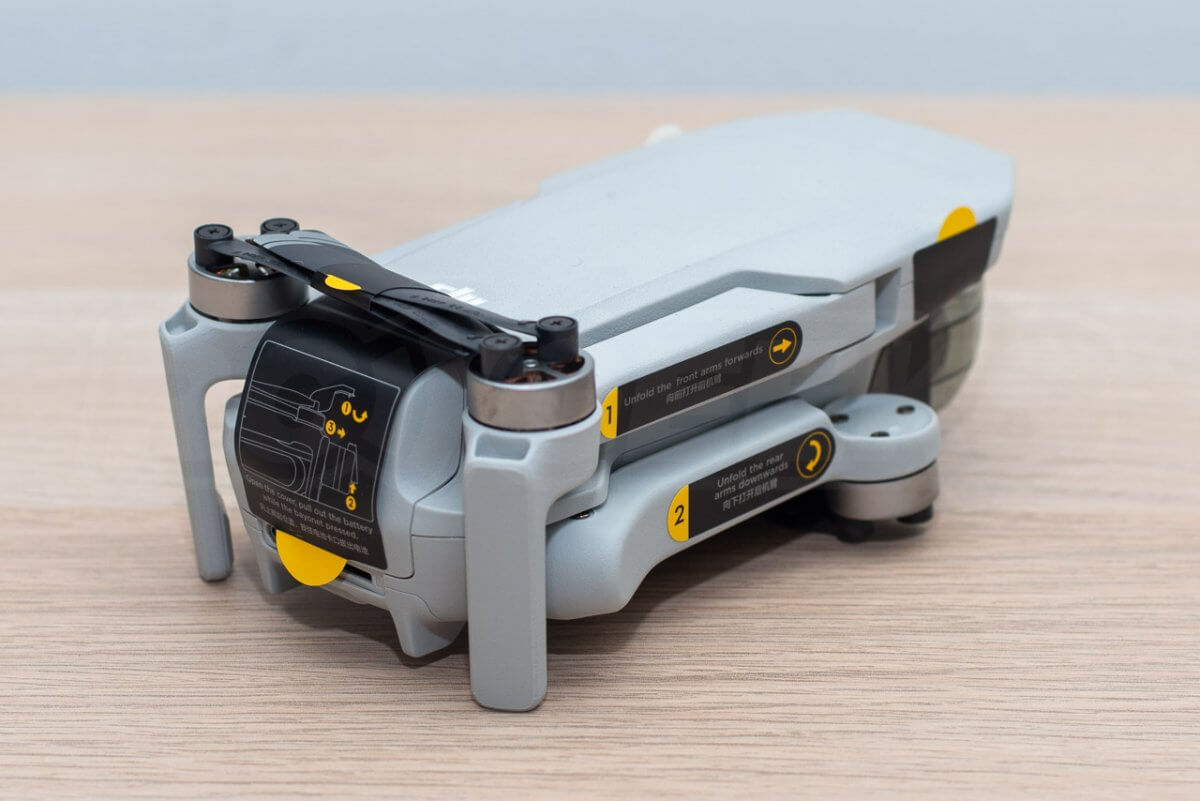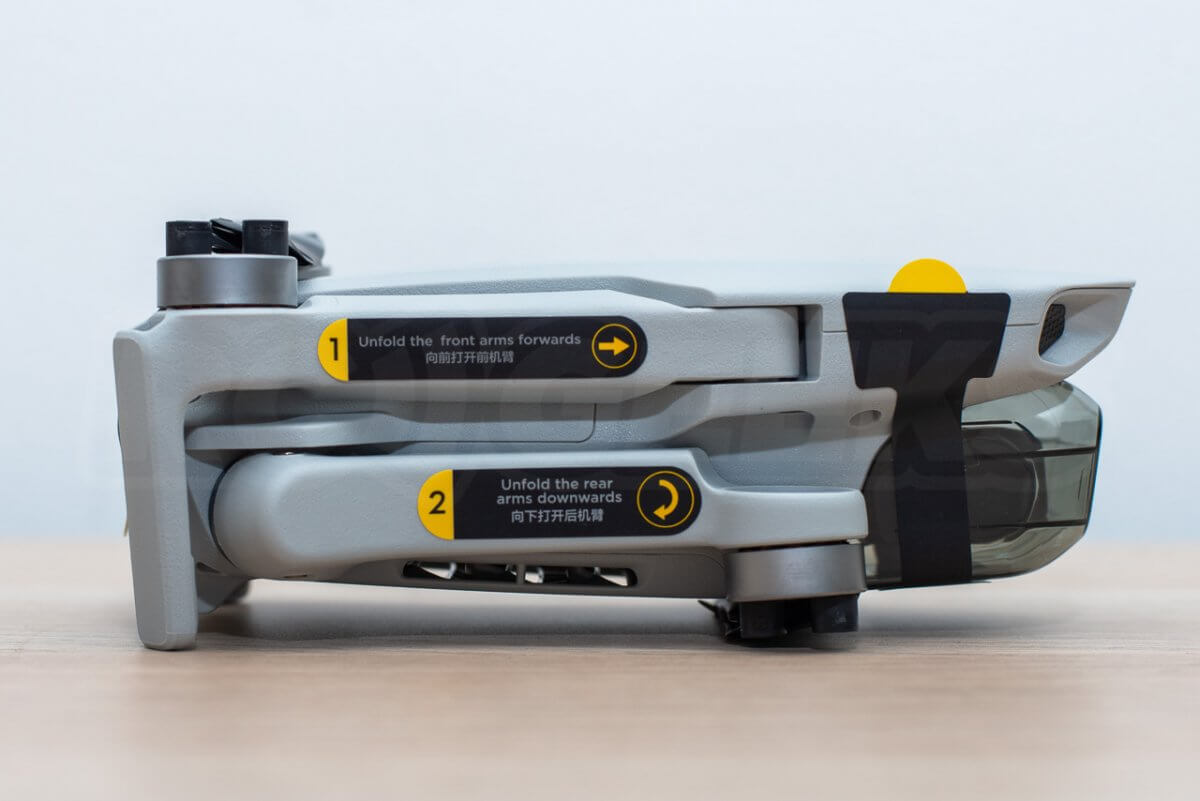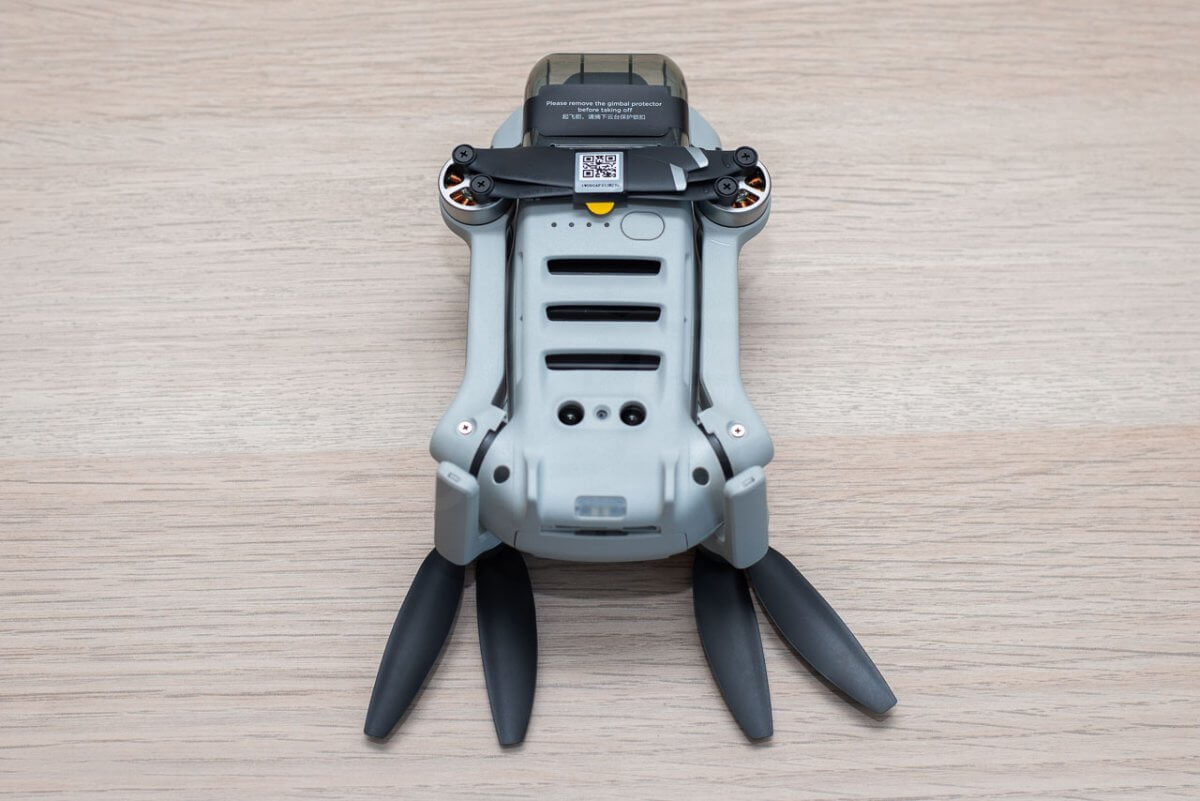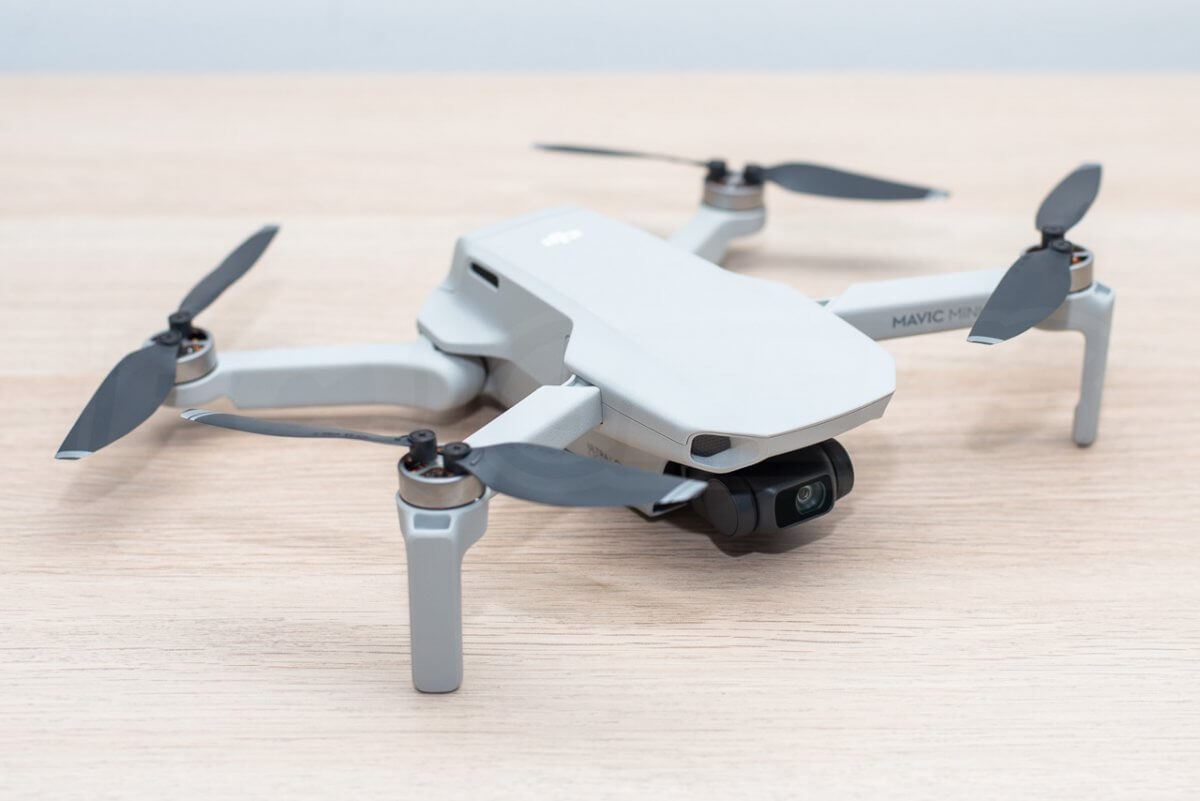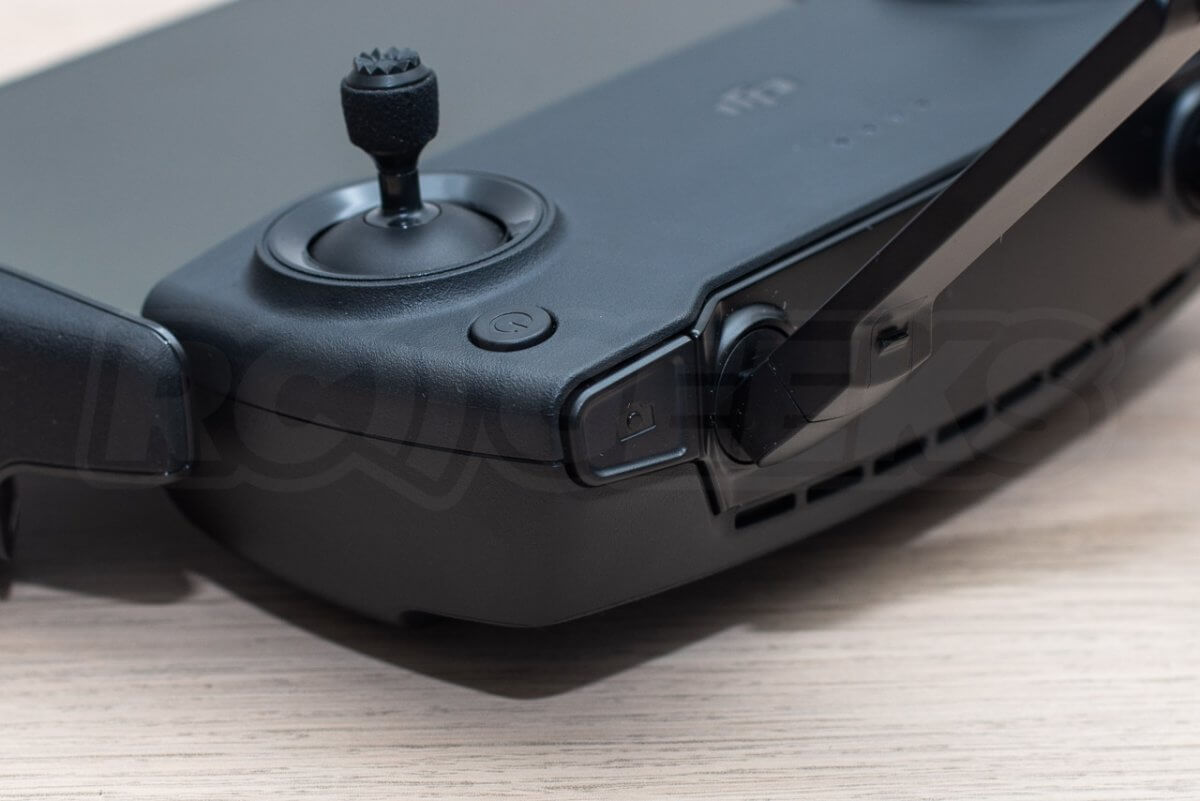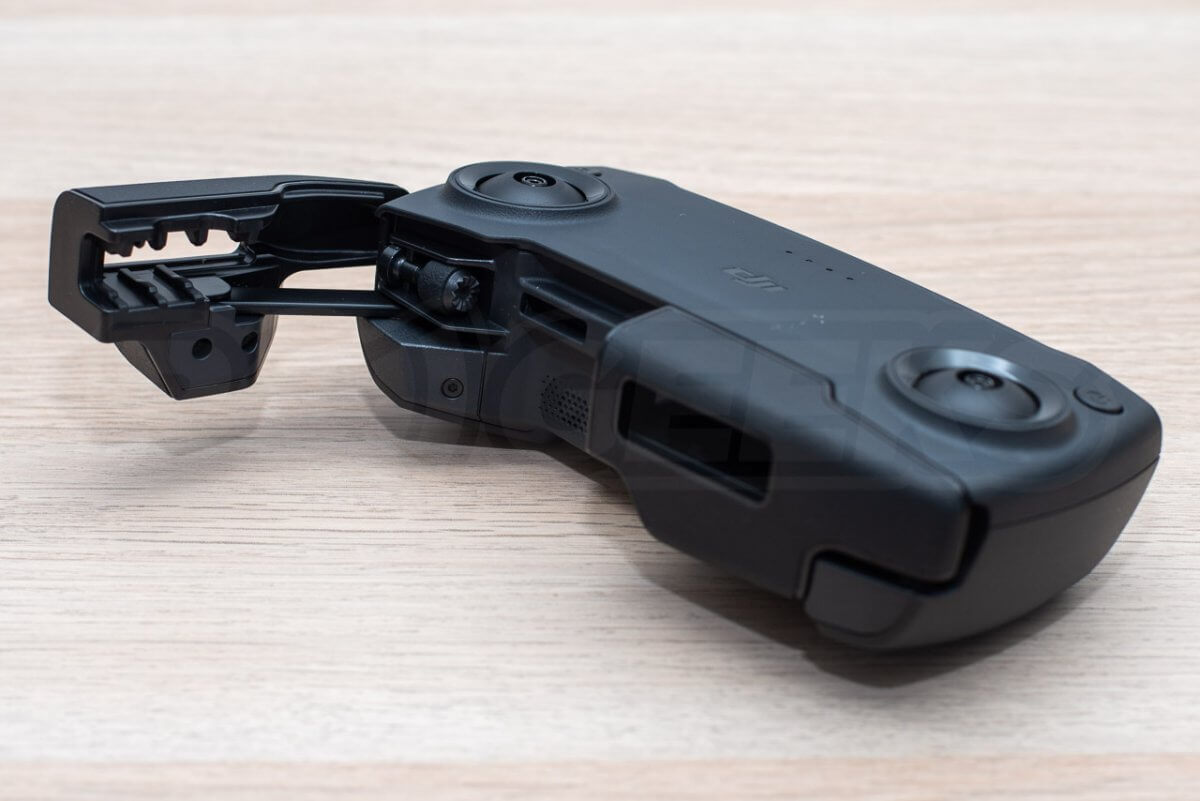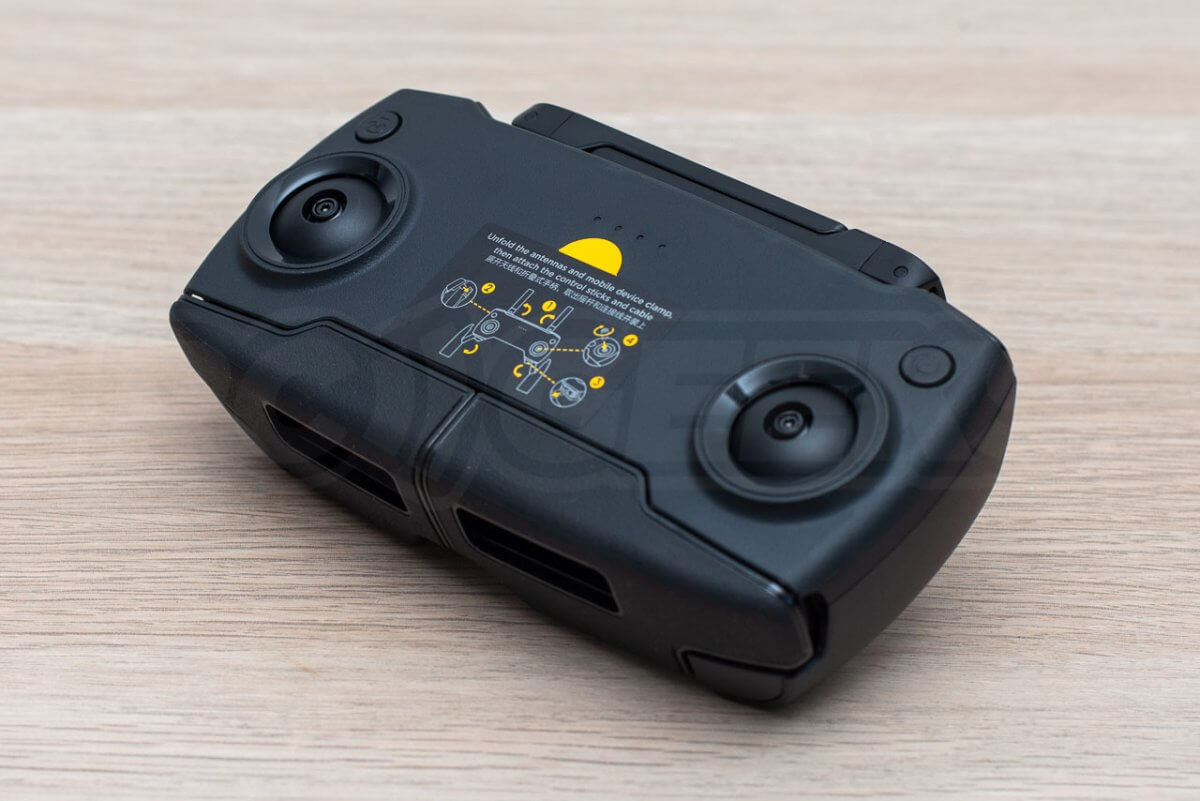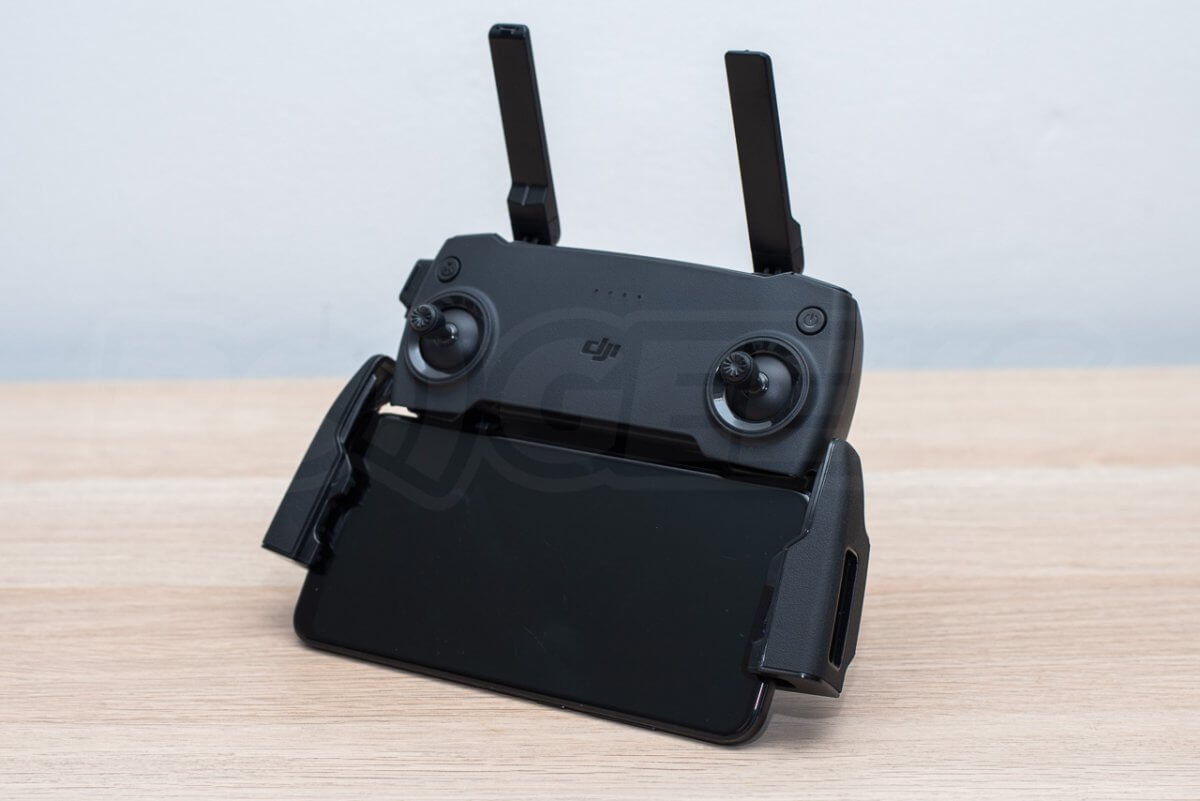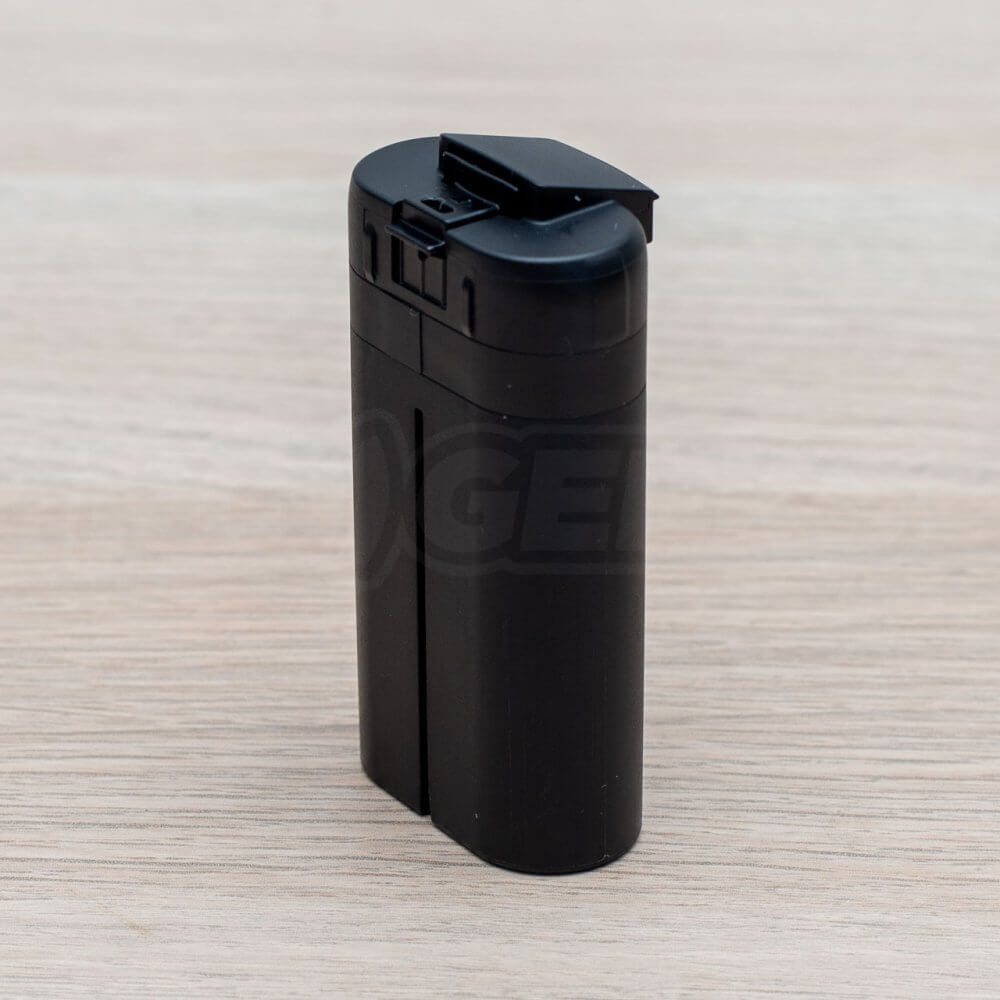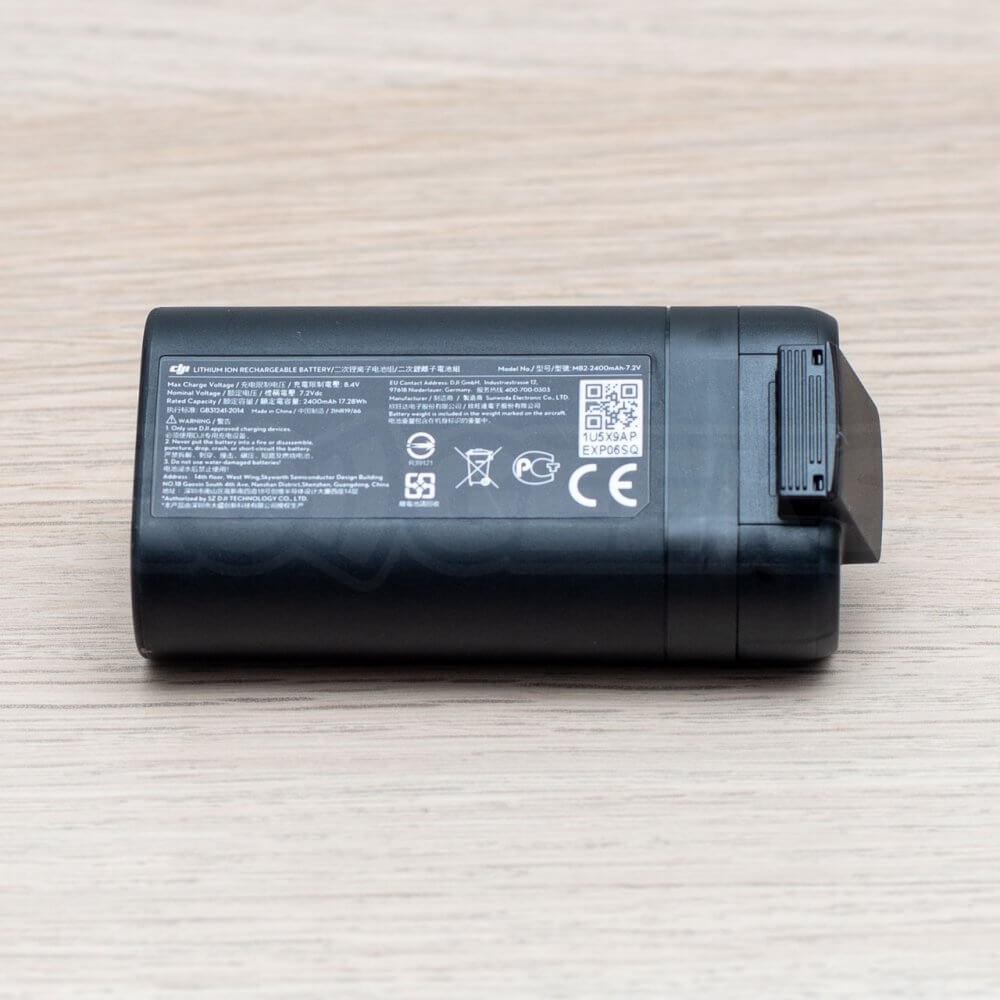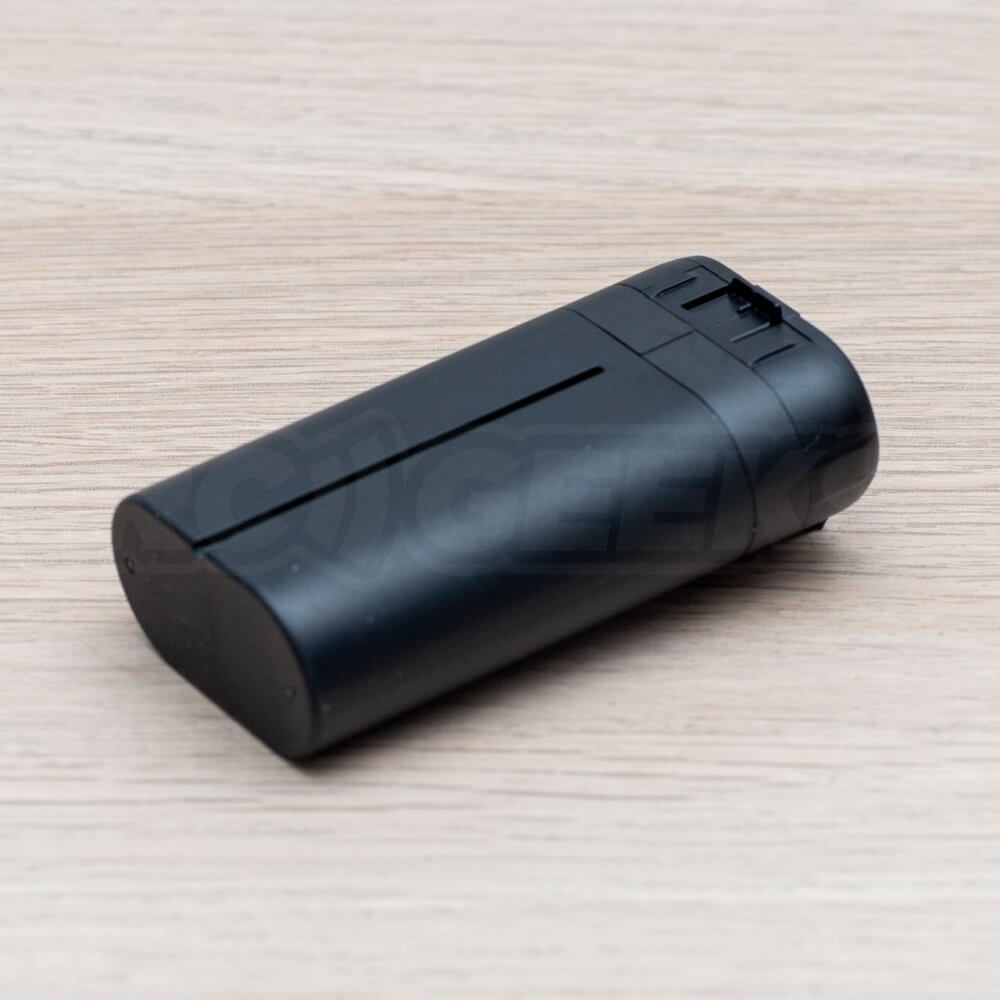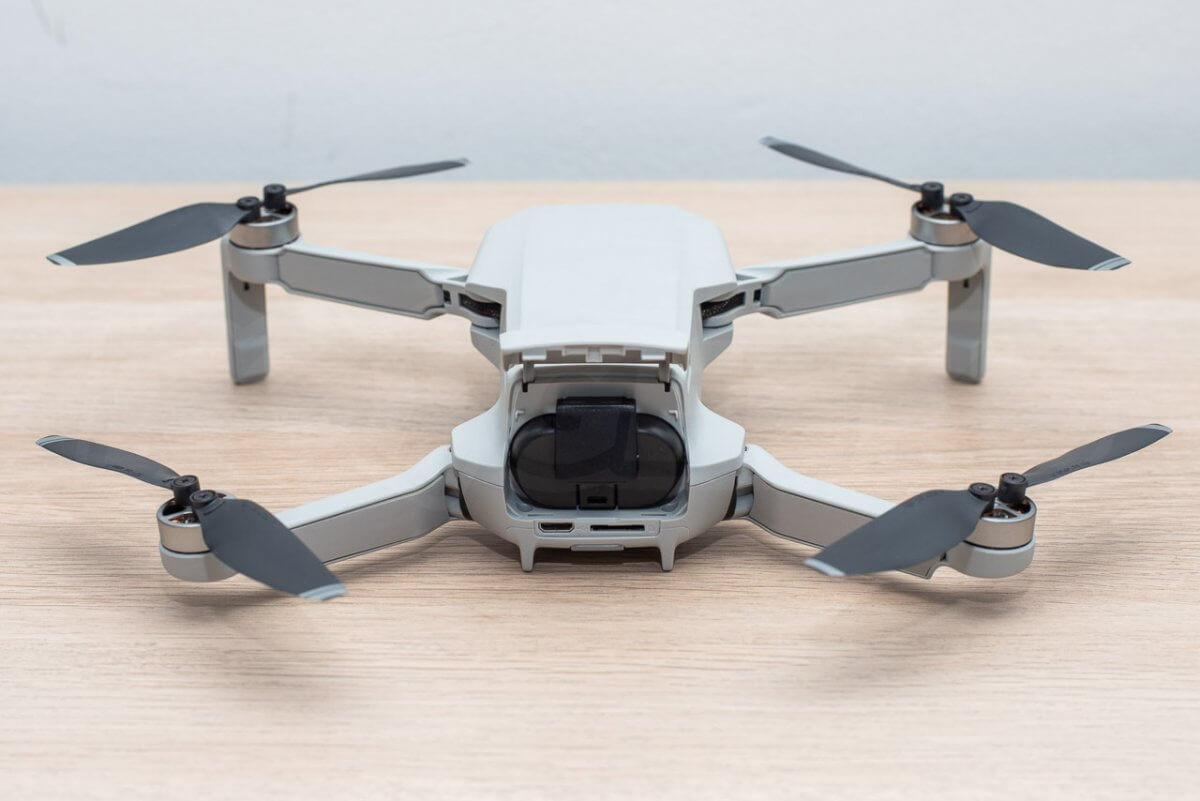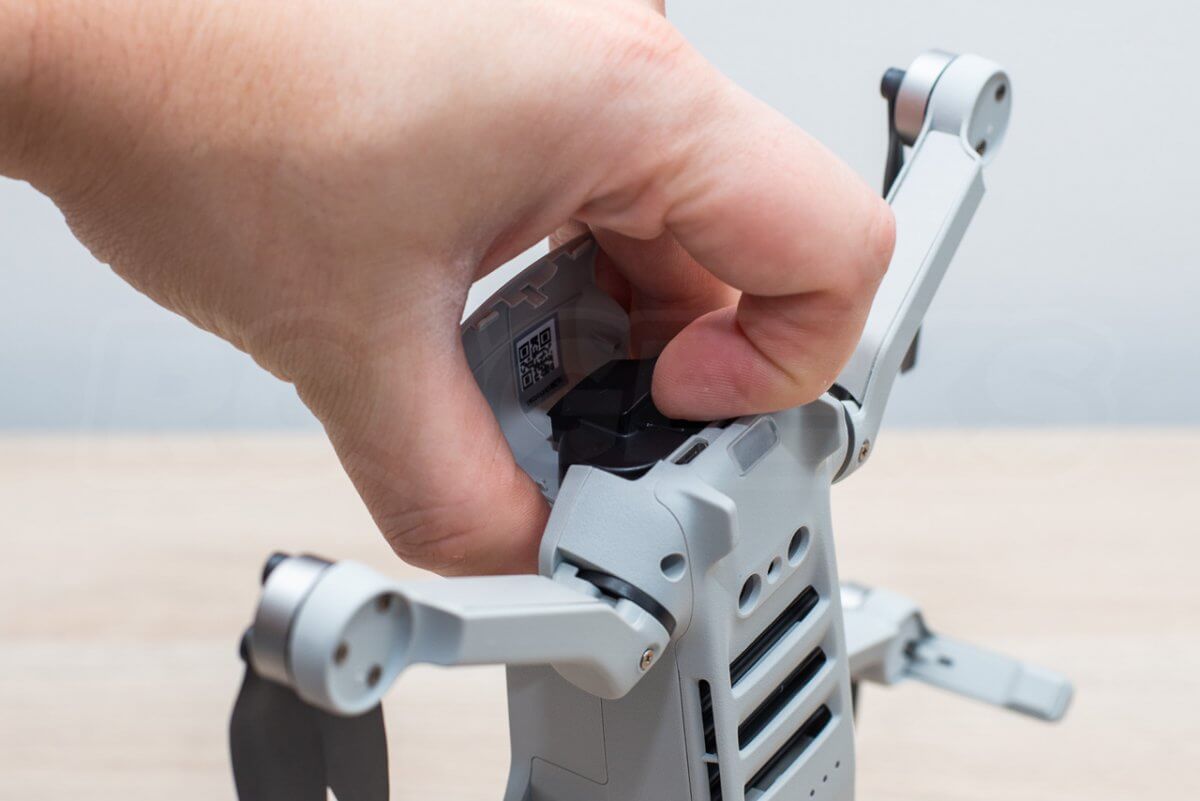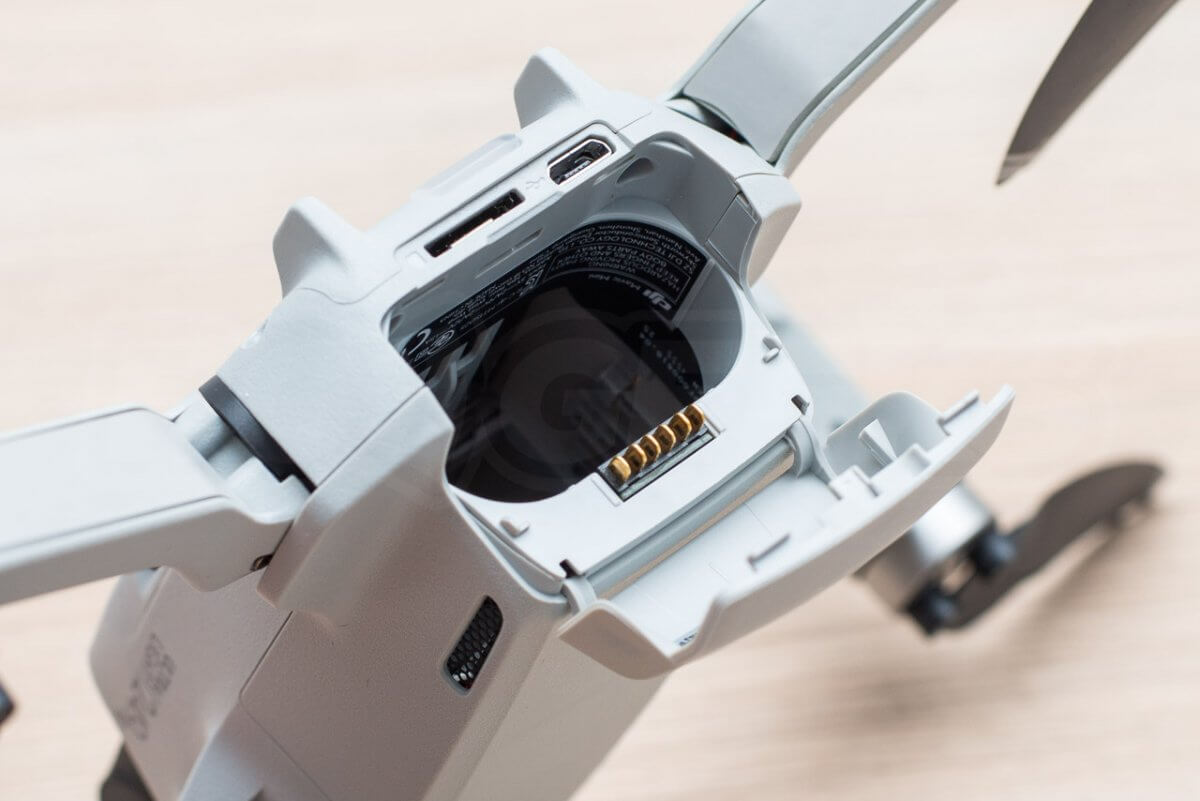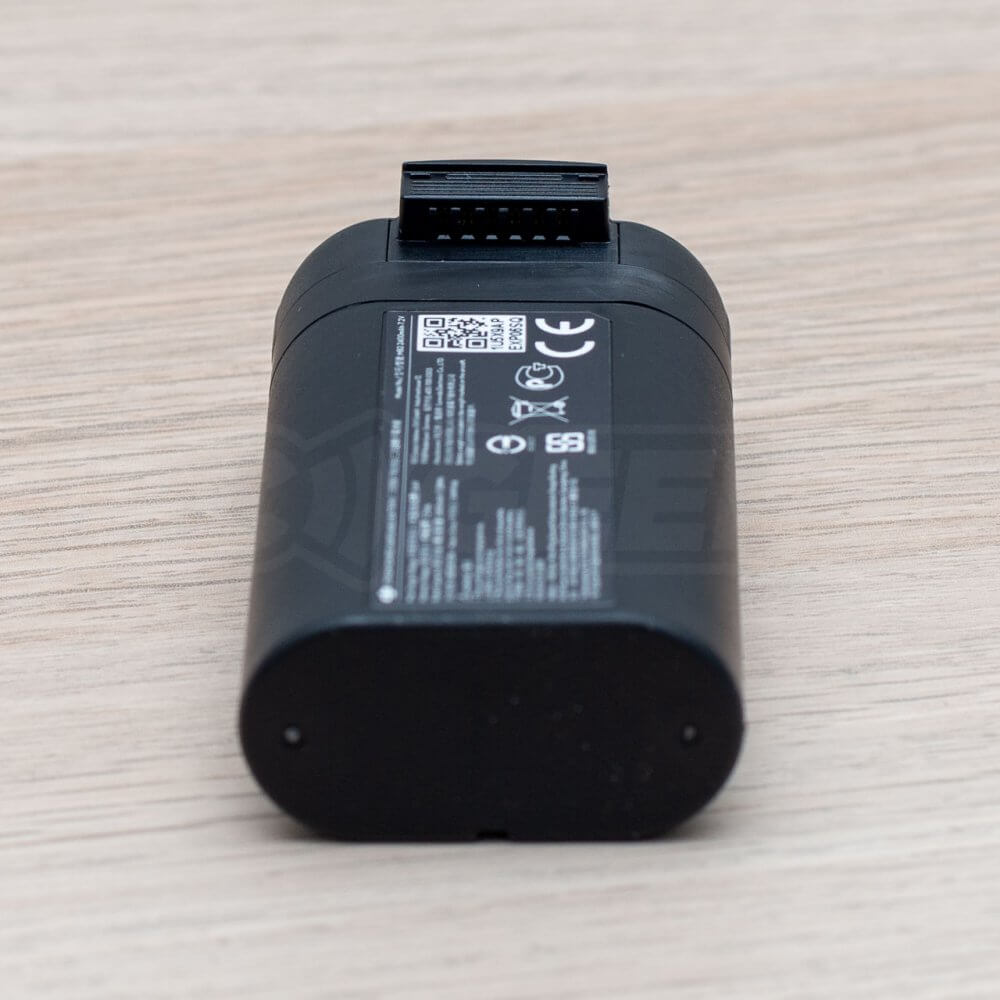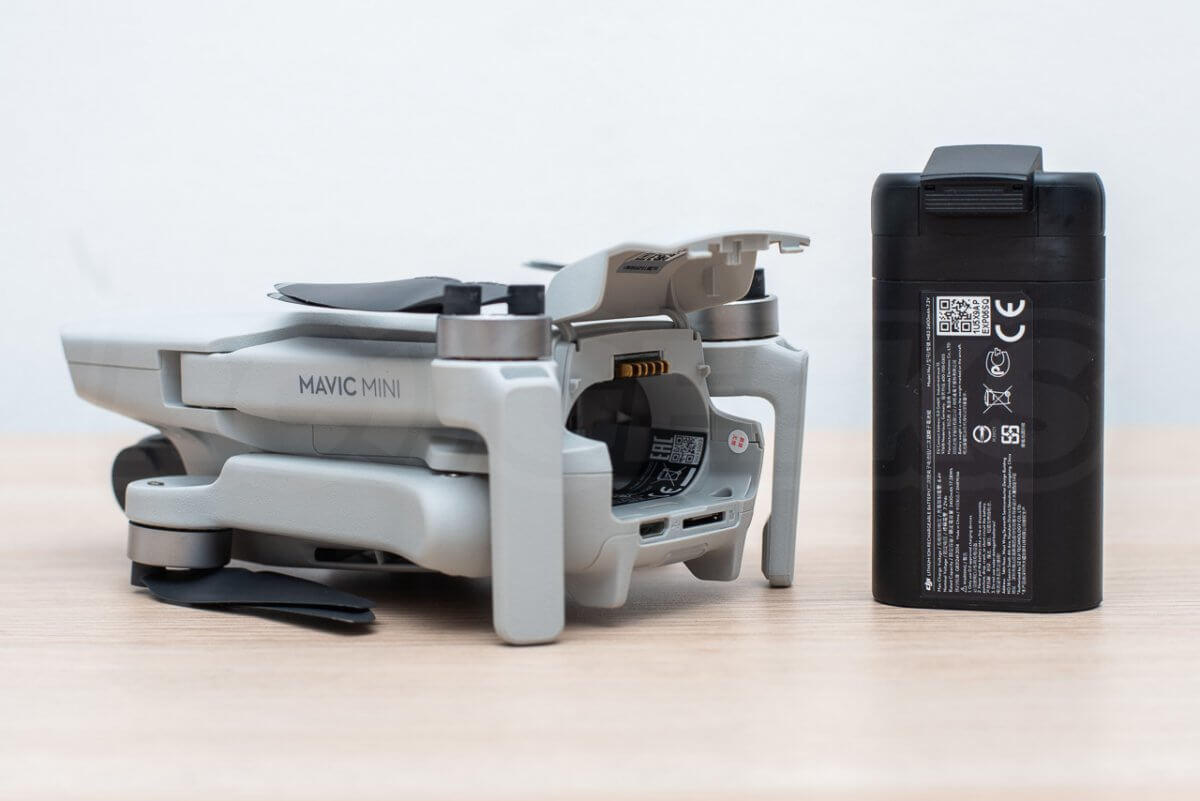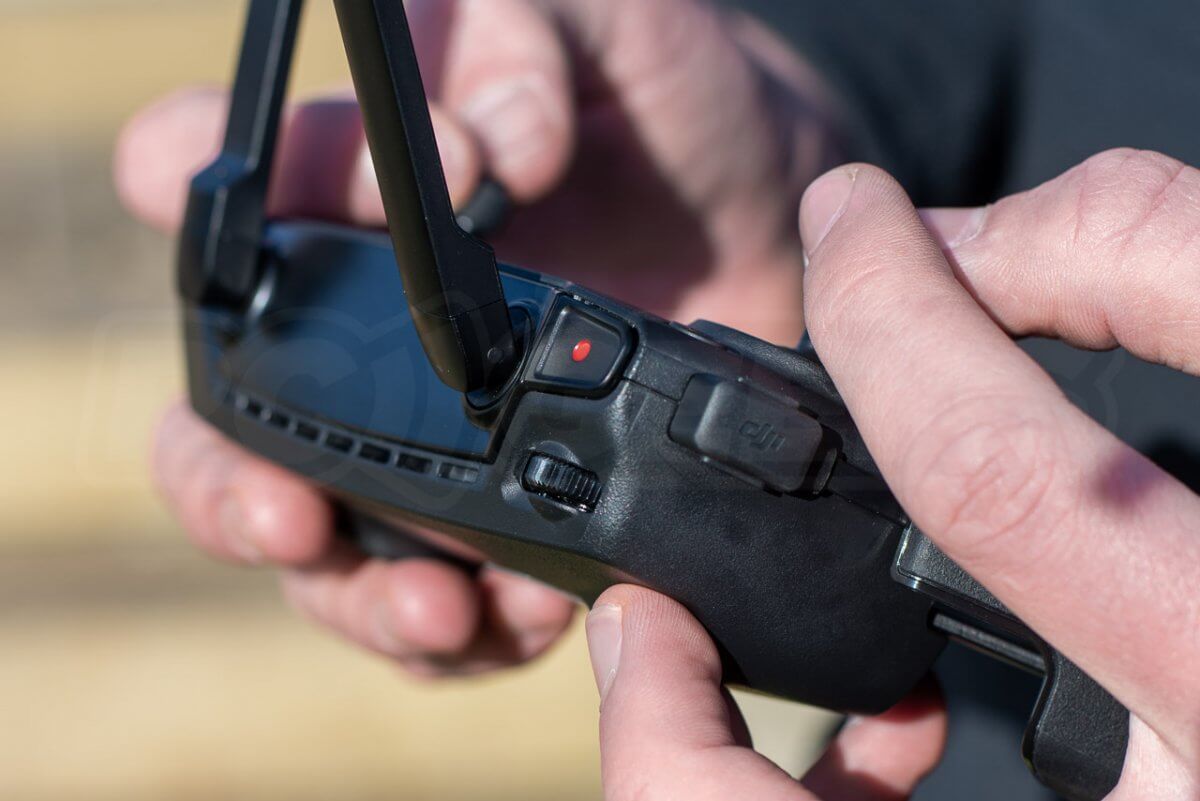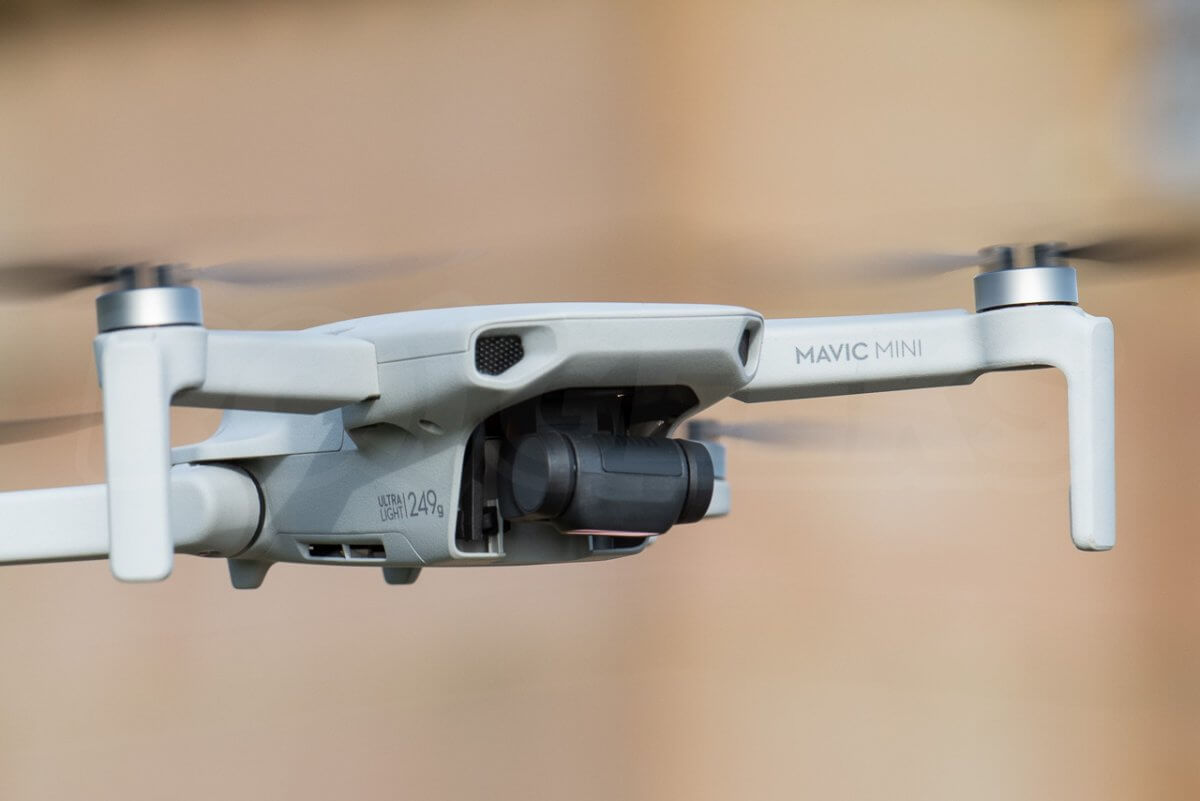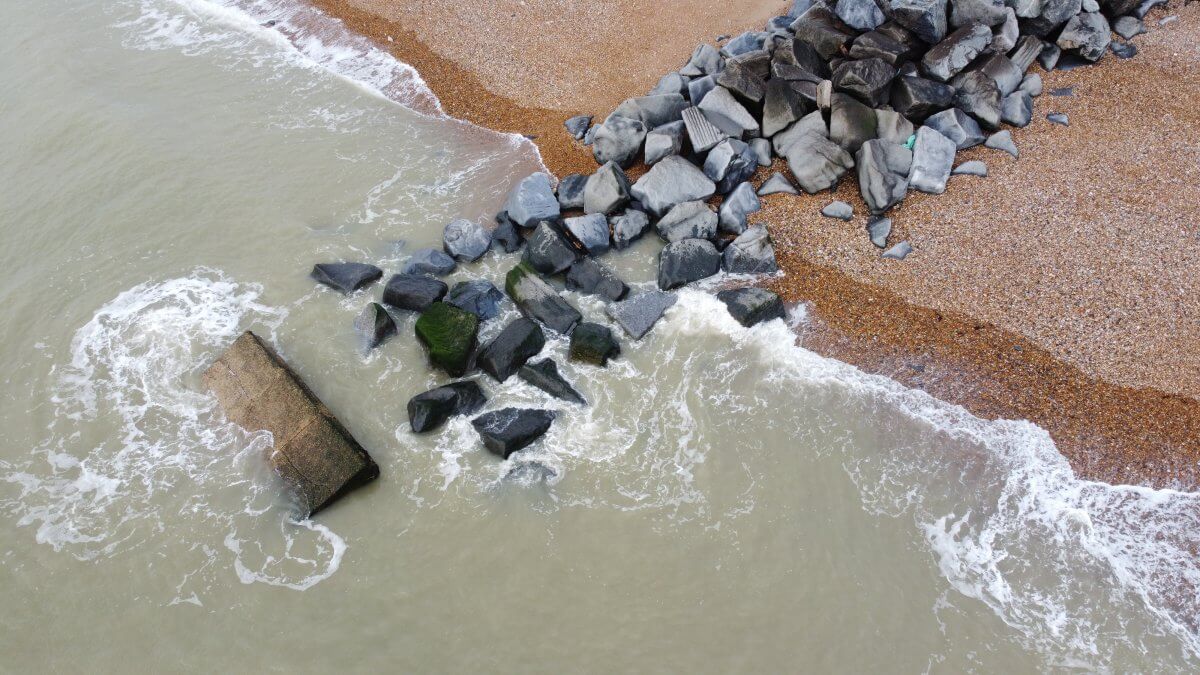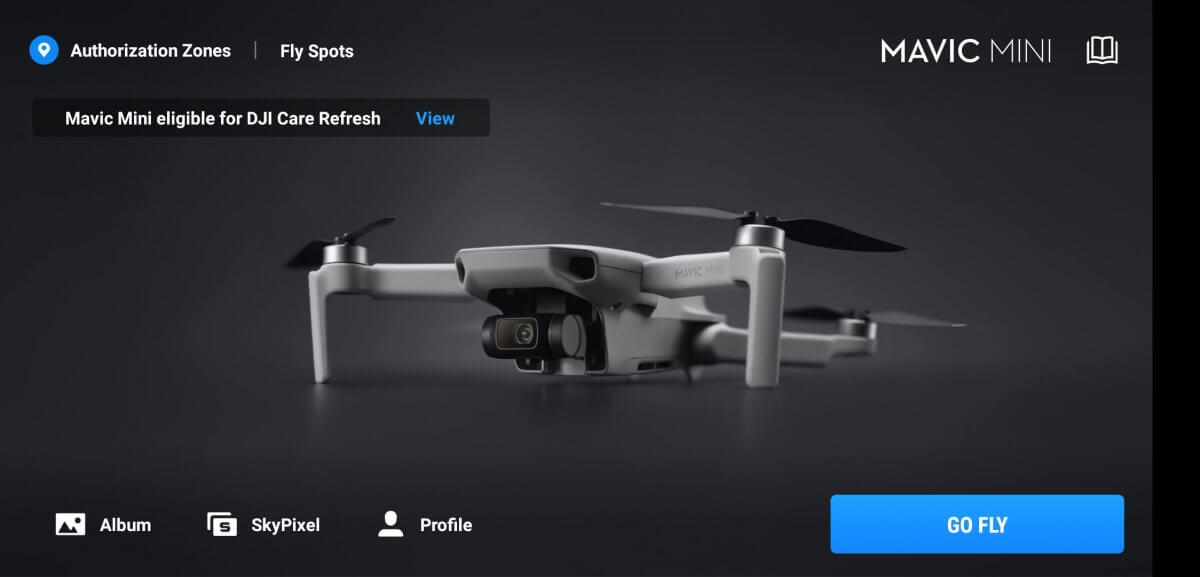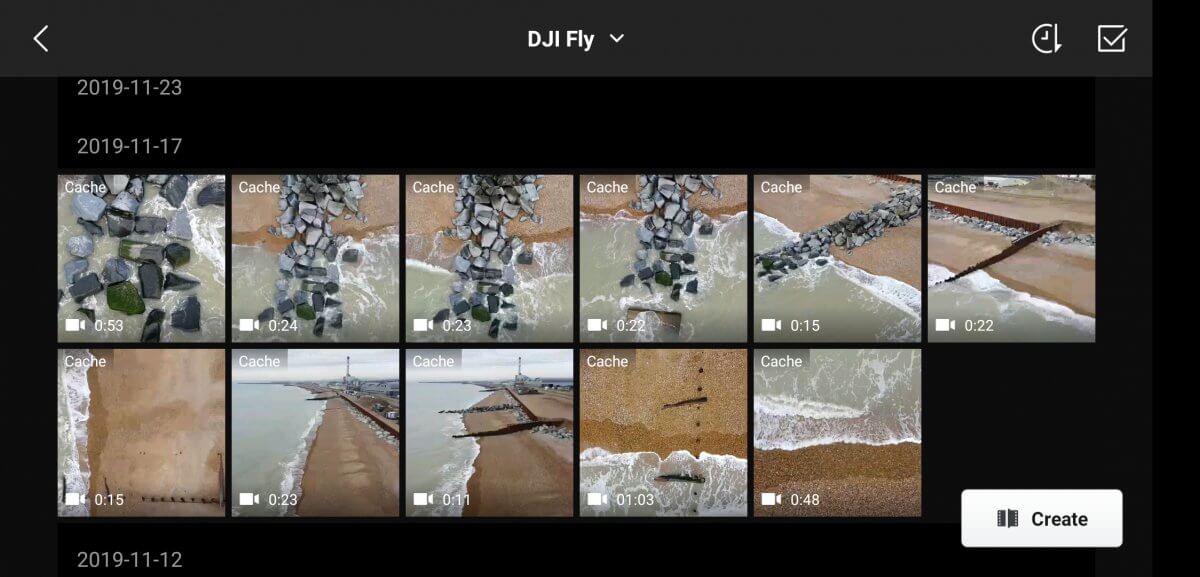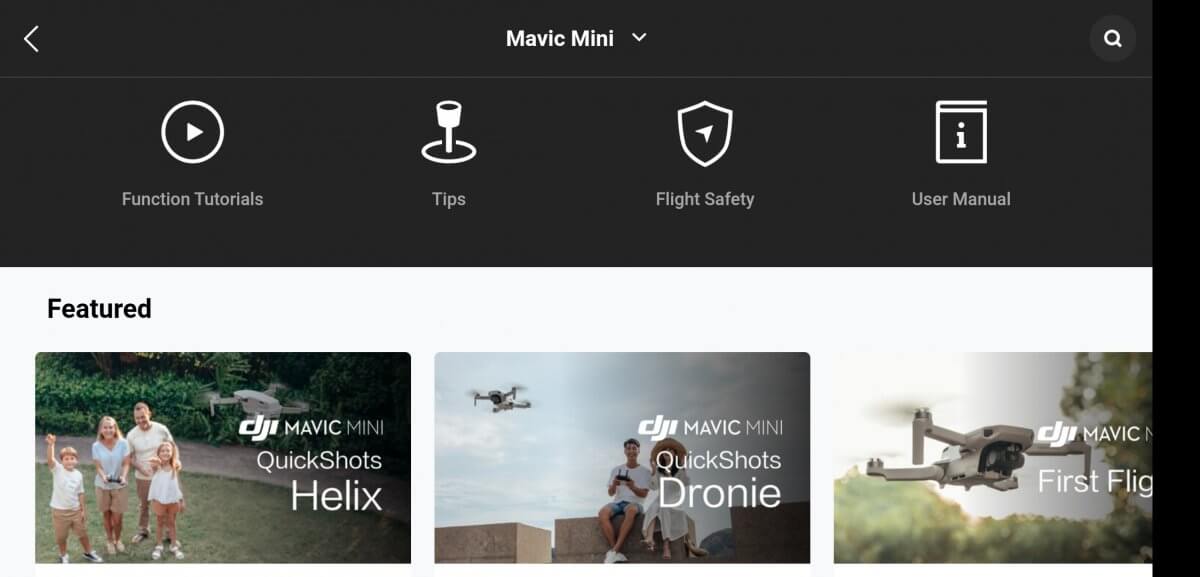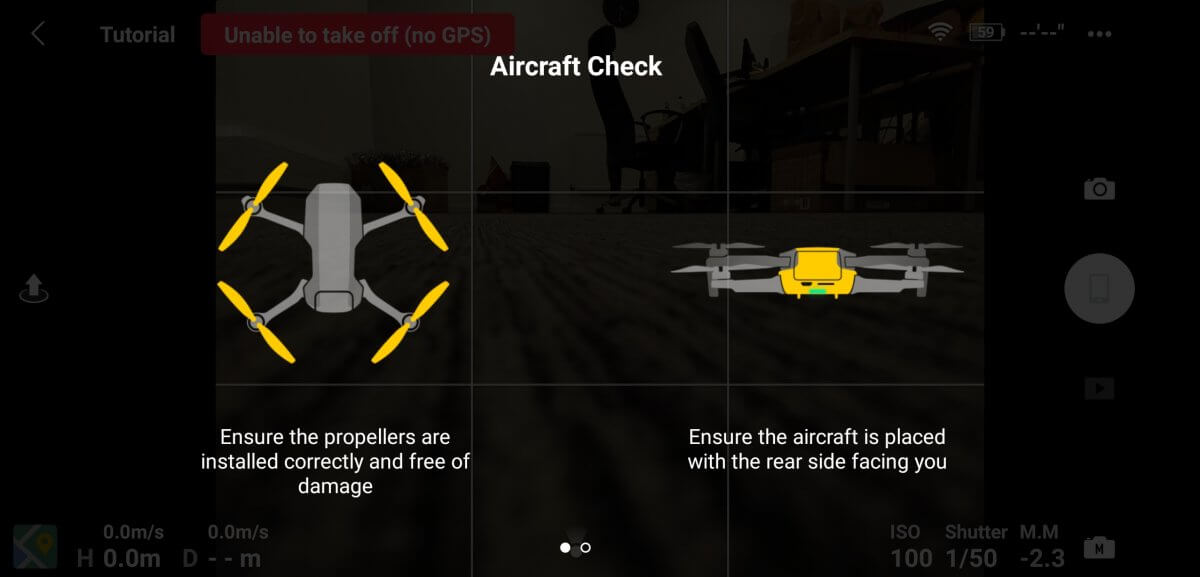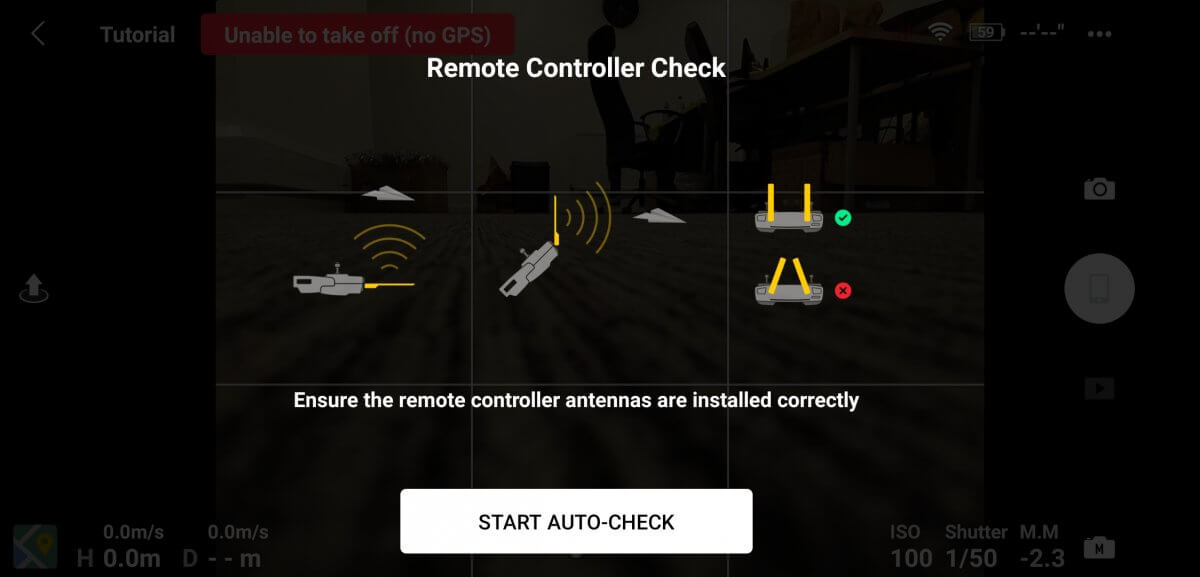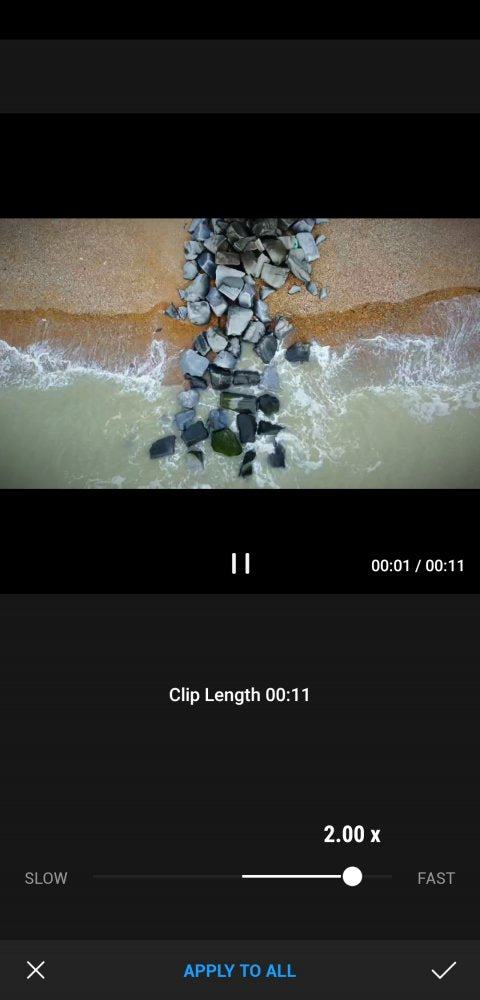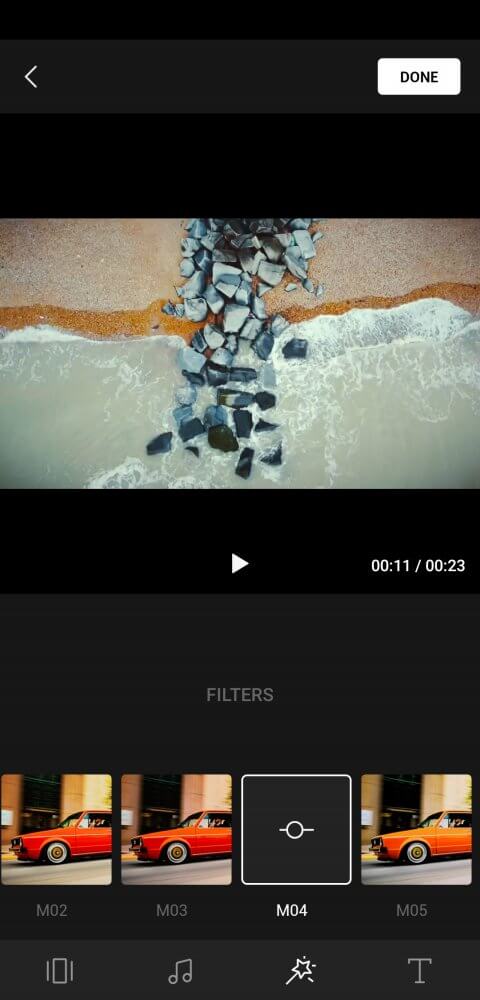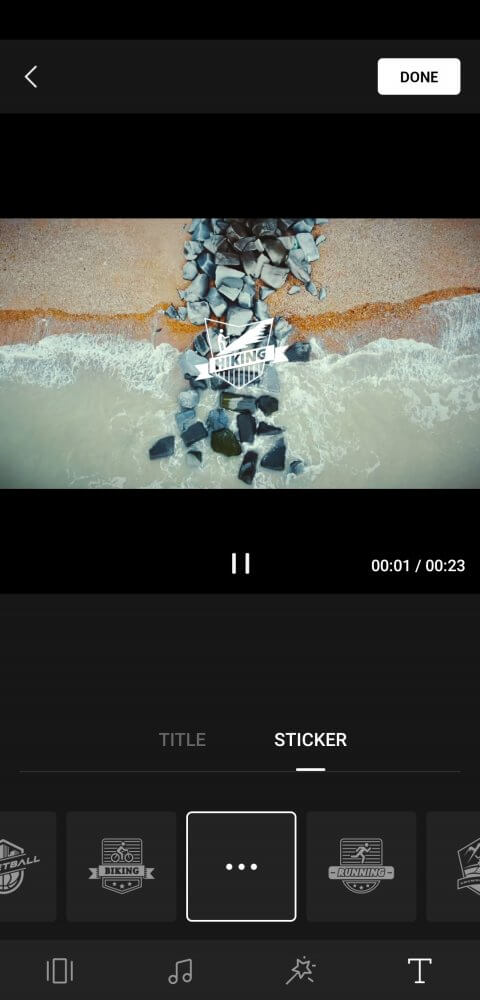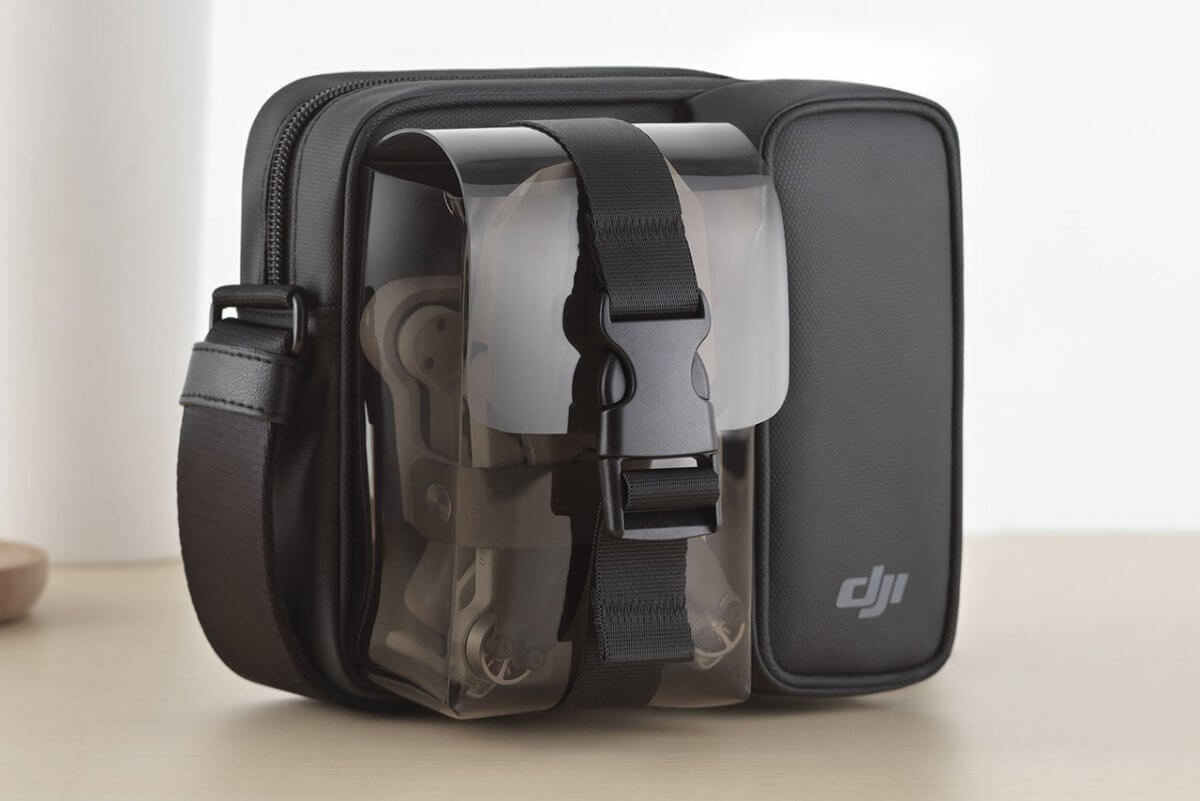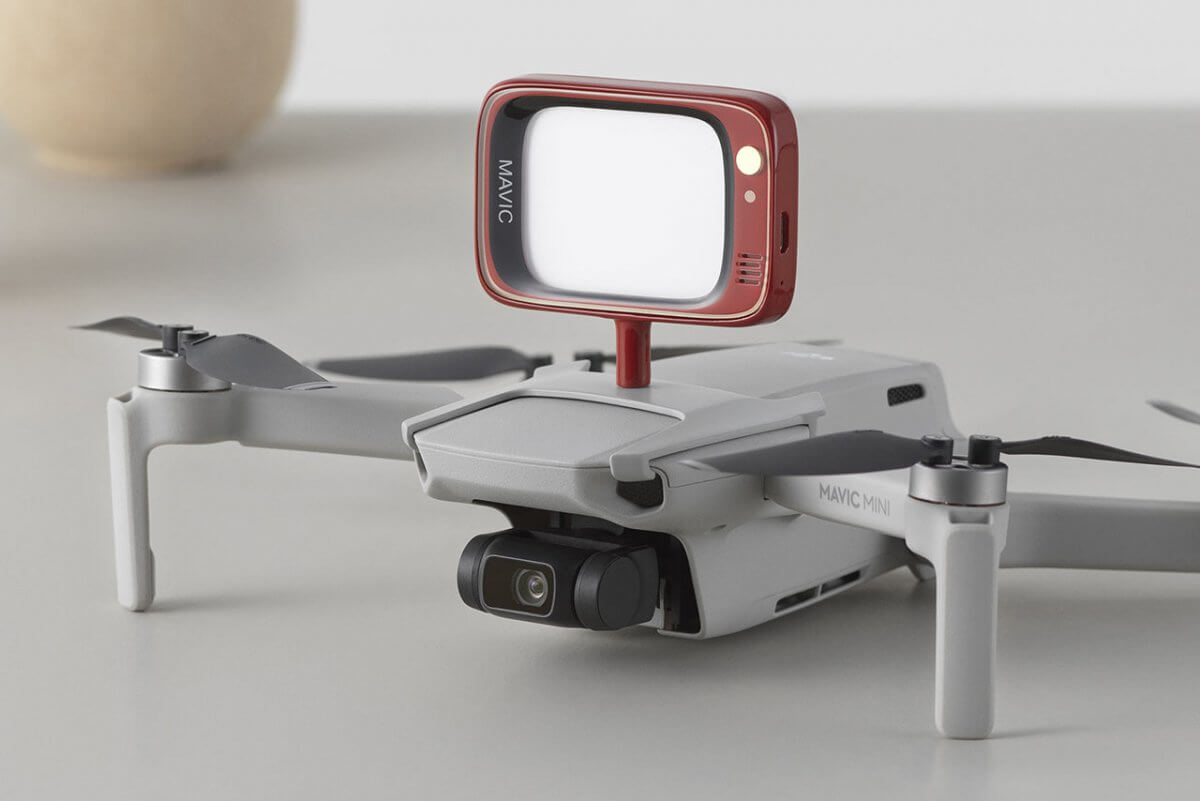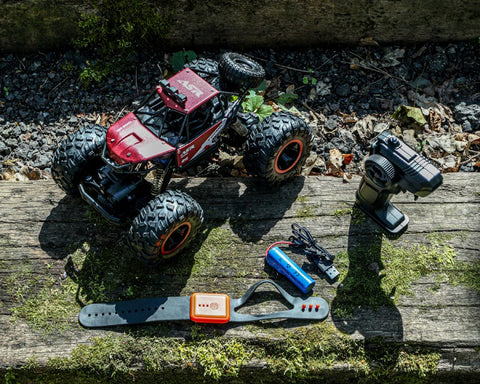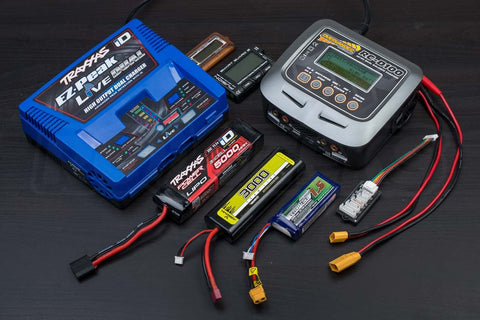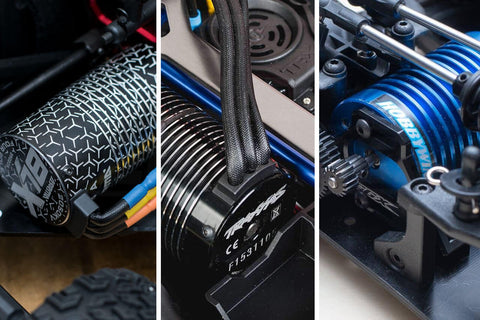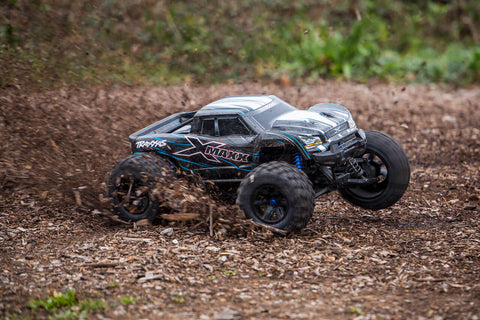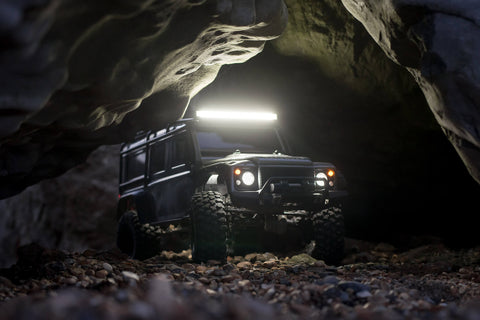In response to a global-shift in drone licensing DJI have released the Mavic Mini. Weighing just 249g the drone does not need to be registered or to be flown by a trained pilot in many territories worldwide. Where does the new drone fit into the Mavic range? Is 2.7k footage enough these days? What can/should you reasonably expect for £370? We unbox the new Mavic Mini to find out.
Mavic Mini at a glance
- Genuinely pocket-sized folding quadcopter
- Featherweight 249g, no requirement to register it in the UK
- 30 minute flight time with user swapable batteries
- 3-Axis gimbal with a camera capable of 2.7K video & 12MP stills
- New smartphone app simplified for recording and editing
- Incredible value, just £370 at launch
Unboxing the drone
We tested the standard Mavic Mini package which ships in a compact 235 by 178 by 85mm sized, flap box.
Alongside the aircraft, the box contents include the transmitter/remote controller, spare pair of propellers, a micro USB cable, gimbal protector and intelligent flight battery (both fitted to the drone), six spare propeller screws (with a small screwdriver to fit them) a spare pair of control sticks and three transmitter USB cables (USB-C/Lightning/Micro-USB) compatible with a wide variety of phones.
Follow the numbered black and yellow stickers to unfold the drone, splaying the front legs outwards before rotating the rear ones outward. Remove the sticker securing the gimbal protector before releasing it from the drone by the clip at the rear. We recommend fully charging the drone via the MicroUSB port on the rear and adding a MicroSD card before powering it up and updating the firmware.
Much like its elders, the Mavic Mini is also available in a ‘fly more’ combo which (as seen in this video) includes two extra flight batteries, 360° propeller guard, two-way charging hub, 18W USB charger, two extra pairs of propellers, an extra micro USB cable, 12 extra propeller screws and a carry bag.
So I don’t need a license or registration?
Lets get this out of the way whilst everyone is still reading. Thanks to its featherweight 249g takeoff weight, in the UK you do not need to register the Mavic Mini with the CAA for an operator ID. There is also no requirement for passing the theory test, granting the user a flyer ID. It appears DJI have created the drone to specifically skirt this requirement in territories across the globe, allowing them to offer products to the ever-growing casual drone market.

This does not mean that the drone can be used irresponsibly. A pilot can still be prosecuted for illegal operation. We strongly recommend all our readers and customers operate their drones in a responsible manner. The drone code is a short guide produced by the CAA that briefly educates users on the laws, it is essential reading.
Compact, folding design
Compared to other drones (and arguably, many tech products) the Mavic Mini is small, really small. At just 140×82×57 mm folded, it’s dimensions are very close to the those of the transmitter and both will easily slip into a jacket pocket or handbag.
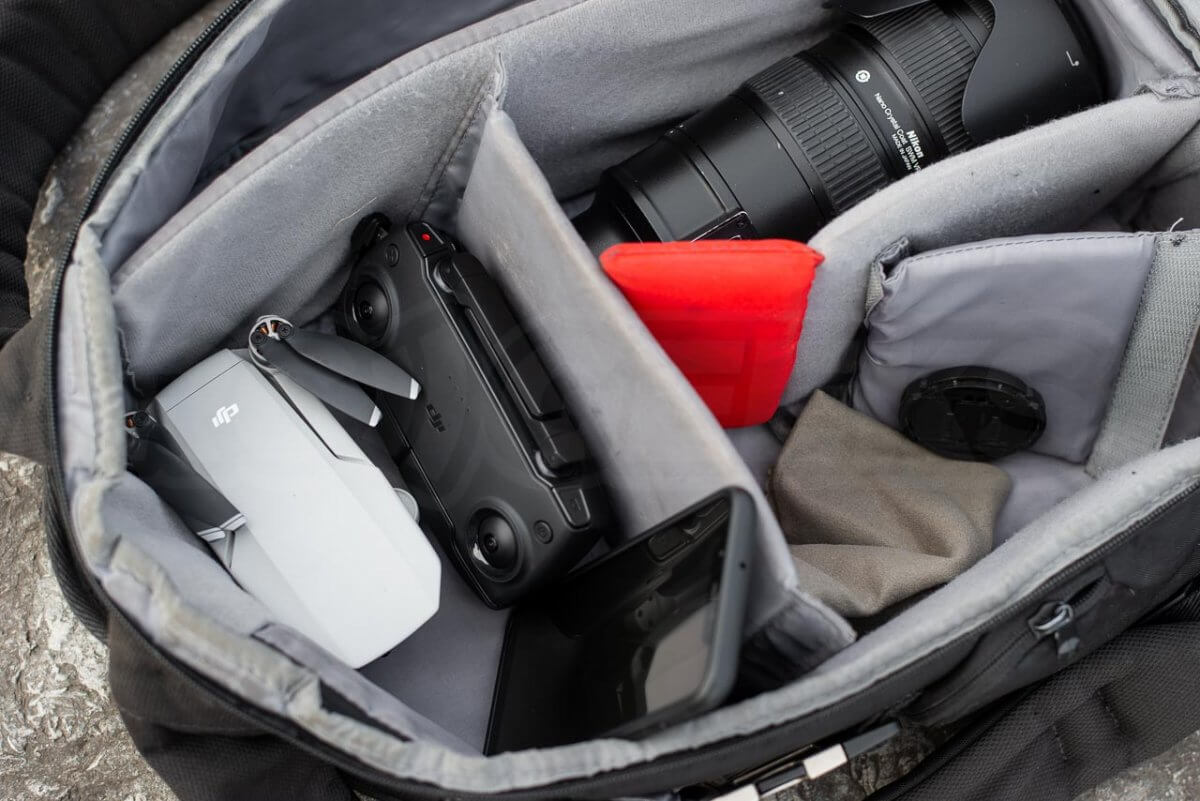
We are always impressed at DJI’s continued miniaturisation of technology and recently took the Mavic Mini apart to see the advances they had made.
Familiar transmitter
Anyone who has flown a DJI Spark or Mavic Air will be familiar with the layout of the included MR1SD25 transmitter. Much like the aircraft itself, it is a compact unit with arms that fold out to hold a mobile device. It will take a 6.2in smartphone with ease, but you will likely have to remove any case you have around it to ensure it grips securely. The antenna arms fold down and gimbal stick ends unscrew, further shrinking the height of the transmitter, the later retained under the fold out arms.
Flying in the UK, DJI claim the transmitter is capable of a maximum 2000m of range over 2.4Ghz and 500m over 5.8Ghz. These figures will be highly dependant on any interference in the area, but we found the connection solid in our test flights over 1km. Its worth noting that at 2km you would unlikely be able to maintain safe visual line of sight of the drone.
Unlike the Mavic Pro controllers, it lacks a display and also a USB port in the bottom. DJI do provide three cables for connecting mobile devices via Lightning/MicroUSB/USB-C (as shown above) but a custom cable will likely be needed should you wish to use a larger tablet when flying.
30 minutes flight time
In ideal conditions DJI claim the Mavic Mini can fly for up to 30 minutes. For anyone with prior drone experience, such a long flight time from such a small battery is always a surprise, the aircraft happily hanging on to 25 minutes even in breezy conditions.
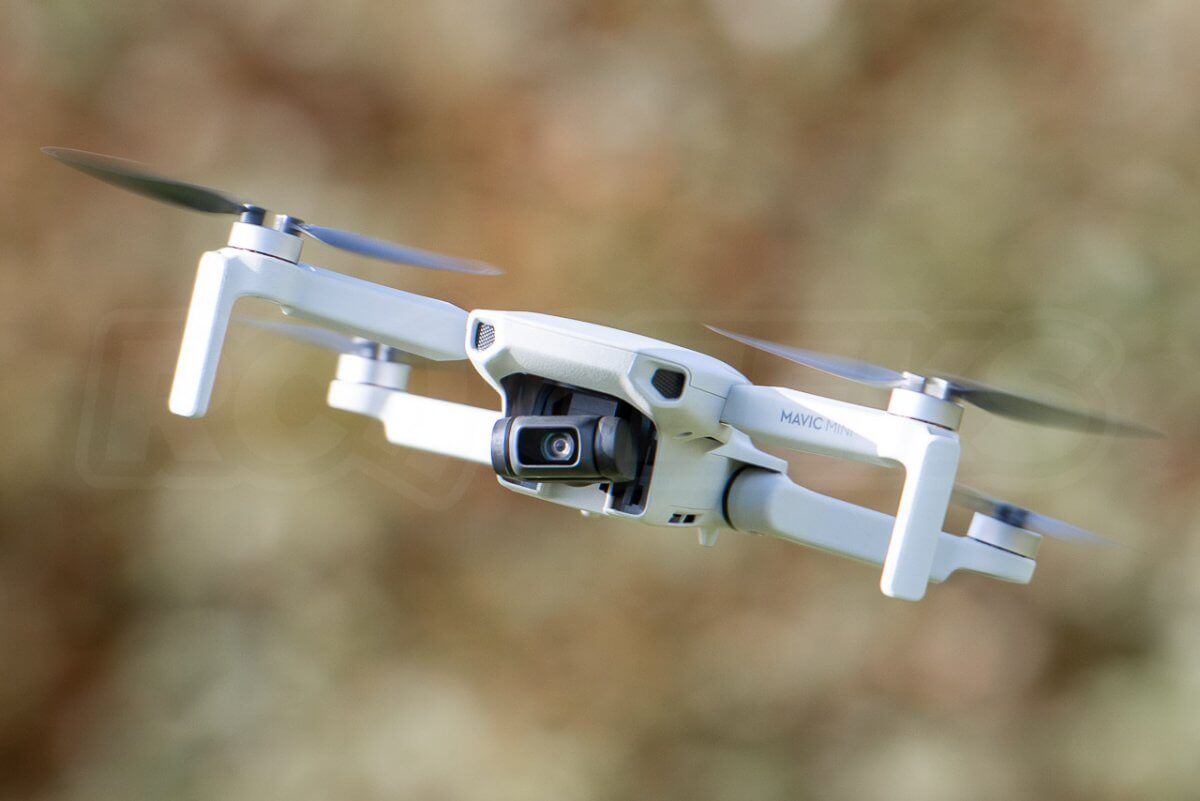
Using a charger such as the 18W DJI unit, the 2400mAh battery can be charged inside the drone in just under 2 hours. Extra intelligent flight batteries cost £45 (at time of release) and we recommend all pilots pick up a few extra when purchasing their drone. Unlike other models, the batteries do not have a readout of their capacity, you must insert them into the drone and tap the power button at which point four LED’s on the belly of the craft will display the current charge level.
To insert or remove the drone battery, ensure the drone is powered down, swing up the rear door on the quadcopter, pinch the chunky square end of the battery squeezing the clip upwards, then slide the battery out of the back of the body. The battery is a tight fit in the drone and it can be fiddly at first.
Don’t get into the habit of flying the drone into the last few percent of the battery. Its not only bad practice (you wont have the reserve power to react should something untoward occur when landing) and it is generally bad for the battery cell life. Its worth noting that DJI recommend charging the batteries to 60% before putting the drone away for any length of time.
Simple to fly
Marketed as the ‘everyday flycam’, the drone has been designed to be incredibly simple to fly. Once you have signed in (or signed up) for your DJI account, the app guides you through the basics of the controls (as well as the readout, such as showing the drone flight-ready status) and suggests best practices for flying. Takeoff is simple as sliding a toggle on your smartphone screen, where the drone will takeoff and hover 1.2m off of the ground.

As with other ‘Mode 2’ transmitters, the left stick controls the throttle and rudder (up and down and left/right rotation to everyone else) whilst the right stick handles elevator and aileron (forward/back and roll, or strafing left and right). A circular power button is on the top right of the controller, tapping it once (when powered down) will show you the battery life, holding it down will power the transmitter on or off. On the opposite side is the return-to-home button, usually reserved for emergencies should you need to return the drone without manually flying it back.
On the front edge are the camera controls, a shutter button by your right index finger and a video shutter button and gimbal control jog-dial by your left. The transmitter is comfortable in the hands regardless if you fly with your thumbs or pinch the sticks as shown. The body is made of hard textured plastic, whilst the lower arms are covered in rubber to grip it in your palms. When it comes to adjustment, you can change the mode or swap the stick directions around, but you cannot currently modify the gains/expo as you can in the more expensive drones.
Flight performance
Right out of the box the drone flies fantastically. We disagree with those who say it has a very ‘Mavic’ signature feel to the flight, there is clearly some refinement happening to your inputs to ensure the drone can fly smoothly and safely rather than the sporty responsive dynamics a Mavic 2 Pro provides. The little motors sing away and can shift the quad-copter in sport mode to a top speed of 29mph (at sea level with no wind).

With its featherweight chassis and tiny motors, the Mavic Mini can accelerate and strafe quickly. In sport mode you may find that particularly strong gusts of wind can tug it off-course due to its lack of mass.
GPS positioning
We flew the Mini in strong winds and it held is position admirably in both Position and CineSmooth modes (the later dumbs down inputs for careful controlled flying). In normal conditions the drone is rock-steady, filling any would-be pilot with great confidence. With the latest update, the drone will not take off if it cannot see at least 8 GPS satellites for accurate positioning.

That same firmware update will allow you to unlock GEO Zones, allowing the drone to fly in restricted airspace once permission has been granted via the unlocking portal. As mentioned, the flight controller will intervene for the best flight experience, limiting the yaw angle to the maximum shown below.
Vision positioning
The two downward facing vision position sensors allow the drone to be accurately flown indoors and when used in conjunction with the GPS data makes the drone impressively steady in flight. You could be mistaken in thinking those small grey vent-things at the front of the drone are front-facing sensors like the Mavic Pro and Spark, alas this is not the case.
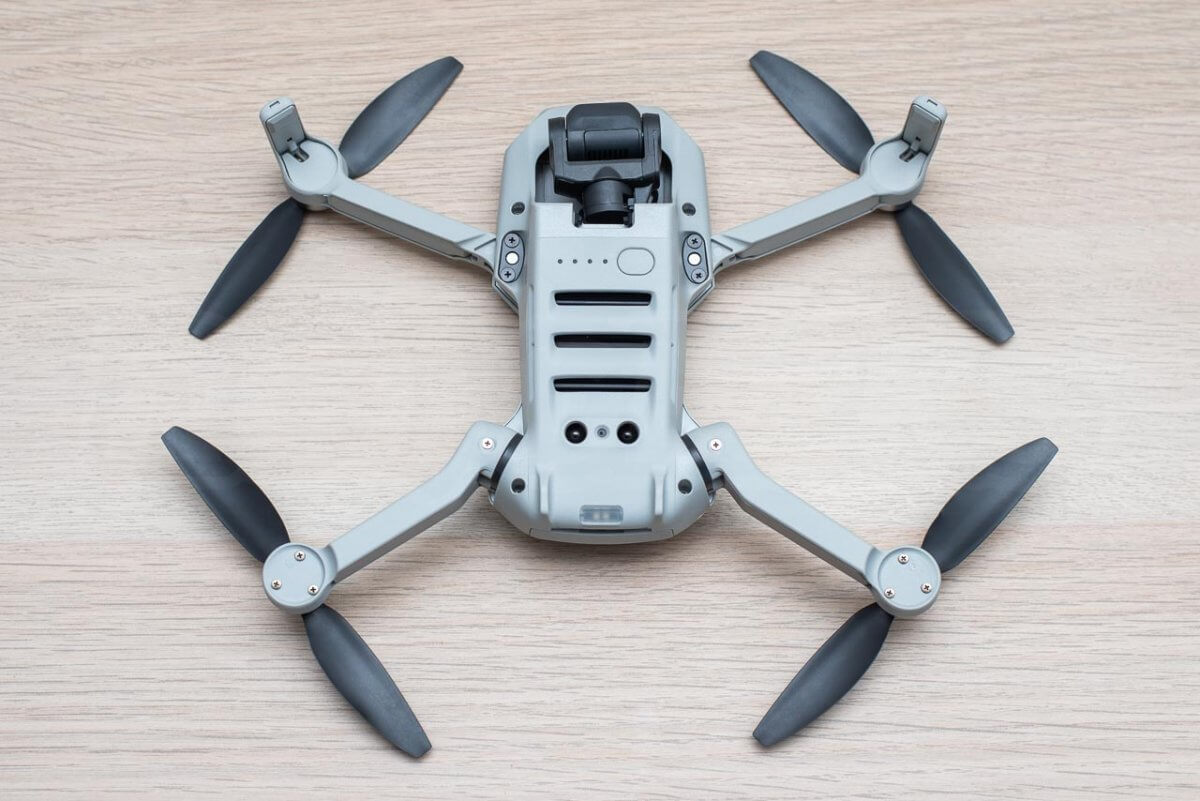
A two-piece propeller cage is also available with the fly more combo. This clips around the legs and encloses the motors and propellers, allowing small bumps into internal walls during flight without stalling the drone out and causing it to fall. When running the guards you should ensure you have selected ‘payload’ mode from the options before taking off.
Retains intelligent flight modes
Whilst the drone lacks the the advanced object tracking of its older brothers it does feature some fantastic Quickshot modes that are ideal for easily creating dynamic video clips. Access these by ensuring the drone is in ‘Mode P’ (change it by tapping the label in the top left of the screen) and then press the rectangle icon on the right hand side of the screen to access the Quickshot menu as seen below
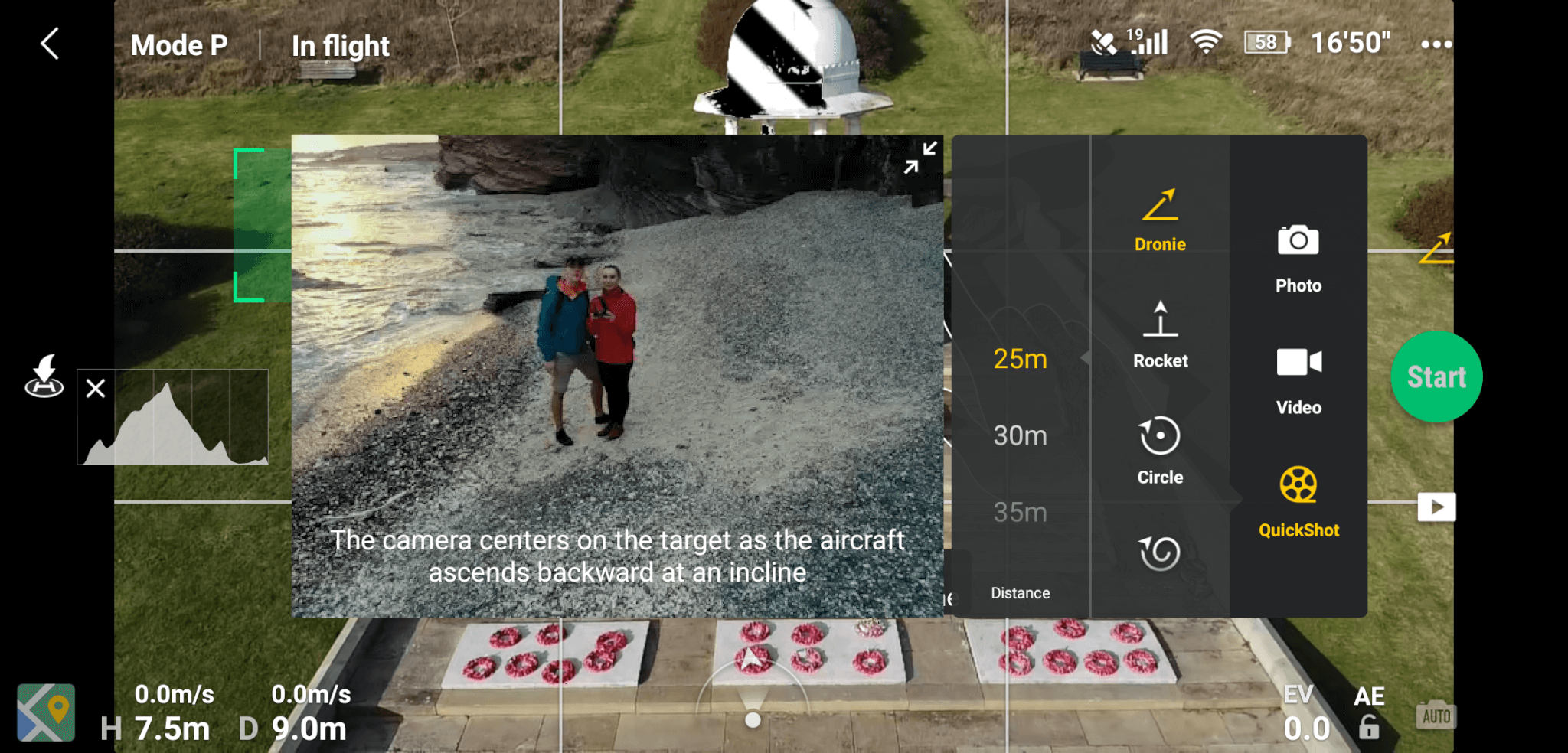
Dronie takes a short 15 second video whilst flying backwards away from a target. You select the flight distance (how far away you want the drone to fly) and pick a target based on the current camera view (either tap on a subject or drag a box around an object as seen below).

Rocket is designed to ascend vertically whilst looking directly down for a wide reveal shot.
Circle will create a 15 second orbit video of a selected subject, using its current distance from the subject as the radius.
Lastly Helix will circle the subject whilst also flying back away from it, revealing the area surrounding the target.
For all Quickshot flights, it is important to ensure that the area around the drone is clear to avoid a collision. Should you need to stop any of the flight modes you can hit the red cross on the screen or tap the return-to-home button where the drone will pause, hovering where it is. All videos can be processed, previewed and edited through the application. Many will be auto-created with music, which can be removed by re-editing the clip through the app.
Regarding the lack of advanced follow mode ‘active tracking’, it is unlikely that the processing power is holding it back from such features, more the omission of front/rear vision position sensors seen in the more expensive drones.
3-axis stabilised gimbal
Mavic Mini features a fantastic, actively stabilised 3-axis gimbal mounted to rubber dampers under the front of the drone. This keeps the camera steady during flight, allowing for relatively long exposure photos or videos. We feel that this tech is taken for granted these days as not so long ago the gimbal alone would have cost more than the price of this entire drone!
The gimbal can angle the camera from horizontal to 90° straight down, using the jog dial on the left of the controller. In the menus an extended tilt up can be enabled giving a further 20° of upwards ‘swing’. As you will have seen in earlier photos, it can also adjust with 35° of roll and 20° of pan to compensate for the airframe angle changing in flight.
12MP aerial photos
The 12MP, 1/2.3” CMOS sensor sits behind a 24mm (35mm equivalent, that is) lens with an 83° field of view. Its fixed-focus has a shooting range of 1m to infinity. It will take photos in in 4:3 (4000x3000px) or 16:9 (4000x2250px) ratios and resolutions and can handle single shot or an interval of 2/3/5/7/10/15/20/30/60 seconds.
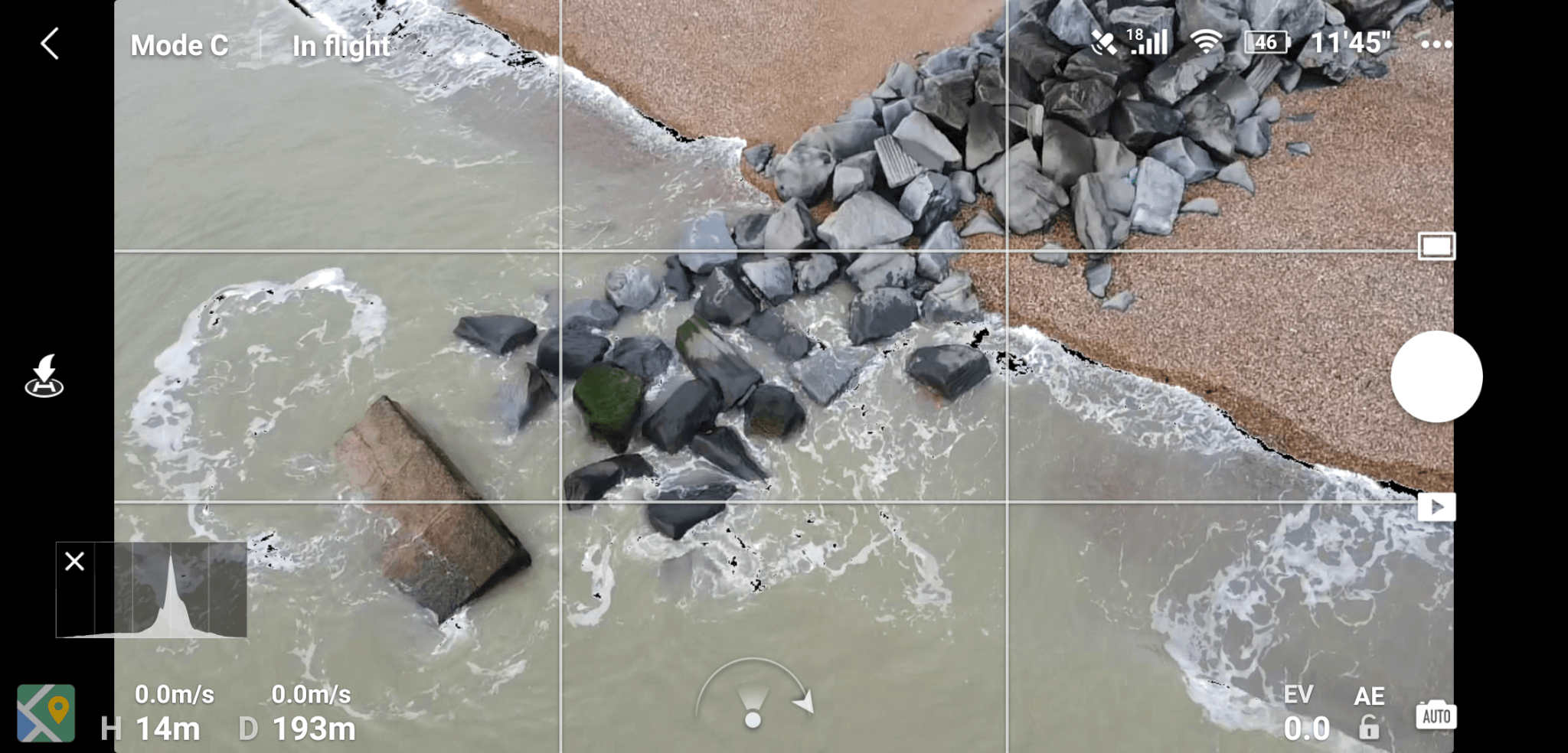
Whilst you can switch between ‘full auto’ exposure and ‘manual’ by pressing the bottom right hand corner of the app, the resulting adjustments are for ISO level (100-3200 in manual mode, capped at 1600 in Auto) and the shutter speed (4-1/8000s). Thankfully DJI have retained the histogram overlay (toggled from the menu and as seen above) to get a better feel for the exposure even when using the EV adjustment in auto mode, ideal on bright days when you have your smartphone backlight set to max and can be mislead as to the exposure. You can also enable highlight clipping zebra’s to help you avoid over-exposing bright areas.
The following photos are straight off of the drone memory card and shot in full-auto mode as many would use the drone:
DJI’s Mavic Mini doesn’t shoot RAW, only JPEG. This will upset some people, but for the target market who are likely to slap a filter onto the resulting image and throw it on Instagram, it is of little concern.
Naturally the images lack the detail of the Mavic 2 Pro, let alone the detail found in the super-photos of the Mavic 2 Zoom, but for the vast majority taking shots in the well lit outdoor environments these drones are likely to be used, the camera quality is fine.
2.7K video camera
That same camera can shoot stabilised 2.7k (2720×1530px) video at 25 or 30 fps and FHD (1920x1080px) video at 25/30/50/60 fps. Whilst the max video bitrate of 40 Mbps is fixed, there is currently talk of DJI adding a 24p mode, likely omitted to separate it from the professional drones.
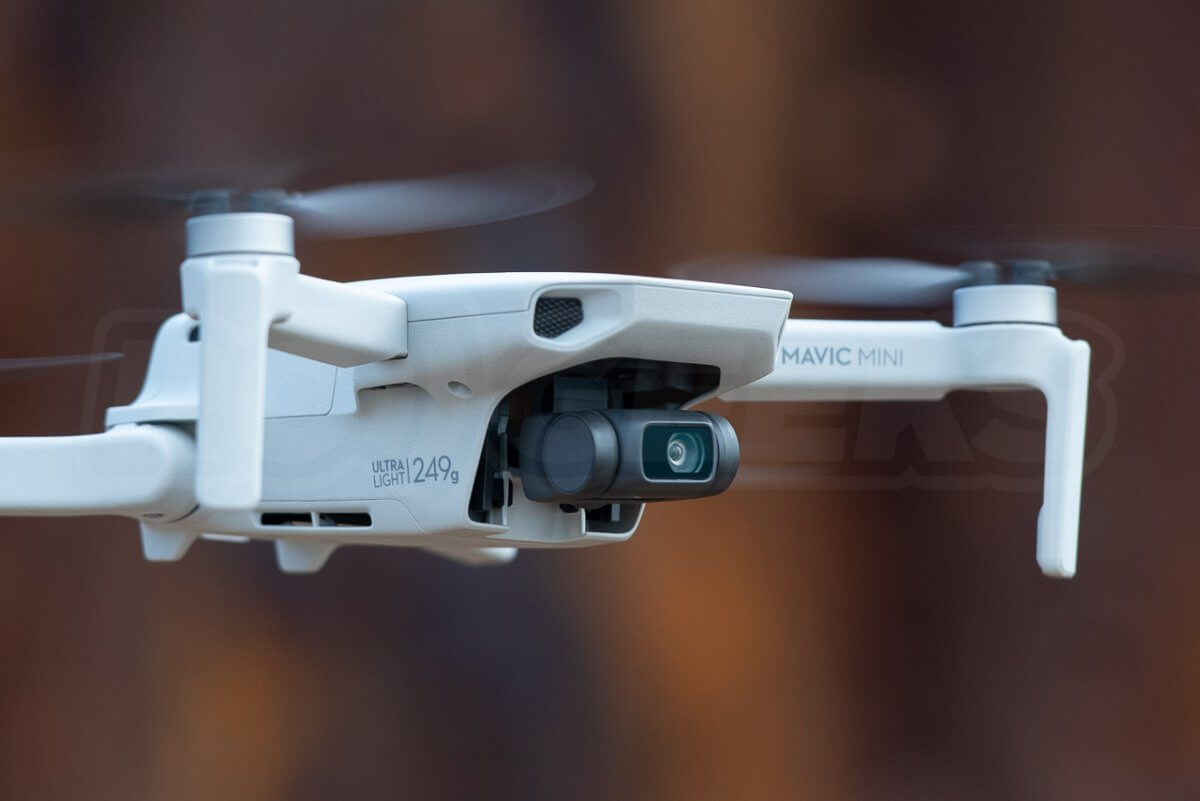
With modern smartphone cameras capable of 4K footage, many will be upset that the Mavic Mini has been ‘capped’ at 2.7k, especially when its older brother the Mavic Air which has very similar specifications can shoot 4k. It is likely that DJI made this decision to avoid cannibalising the market for their more expensive drones. For the most part, we feel that most users will be uploading compressed 1080p clips to social media platforms and will not be concerned about the quality.
In very low-light, with a small sensor and limited ISO adjust-ability, the Mavic Mini struggles with noise. This may be a mute point for many as following the latest firmware the Mavic Mini can refuse to take off if the environment is too dark to operate in.
Revised smartphone application
DJI Fly is an all-new application for iOS and Android. It is a more paired-back app than the previous DJI-Go iterations and ideal for complete beginners. It retains the structure of ‘live camera view’, ‘album’ view but de-clutters the menus.
This clean up continues in the live view, with the UI simplified, clutter removed for a basic appearance. As standard, the map view is hidden, the distances from the pilot are displayed with just simple bold white text, as has the current flight mode. The signal indicators are now just icons with current charge level and flight time as simple countdowns.

Video editing has markedly improved with the ability to quickly bundle clips together, reverse their direction, re-tone them with preset filters and add music and text overlays in just a few taps.
The overall experience is much slicker, its user friendly interface more suited to the casual user that the Mavic Mini will attract.
Mavic Mini Accessories
A whole host of accessories were announced at launch for the new drone. DJI’s Mini bag will carry not only the drone but also its other cameras such as the Osmo Action and Osmo pocket alongside the drone.
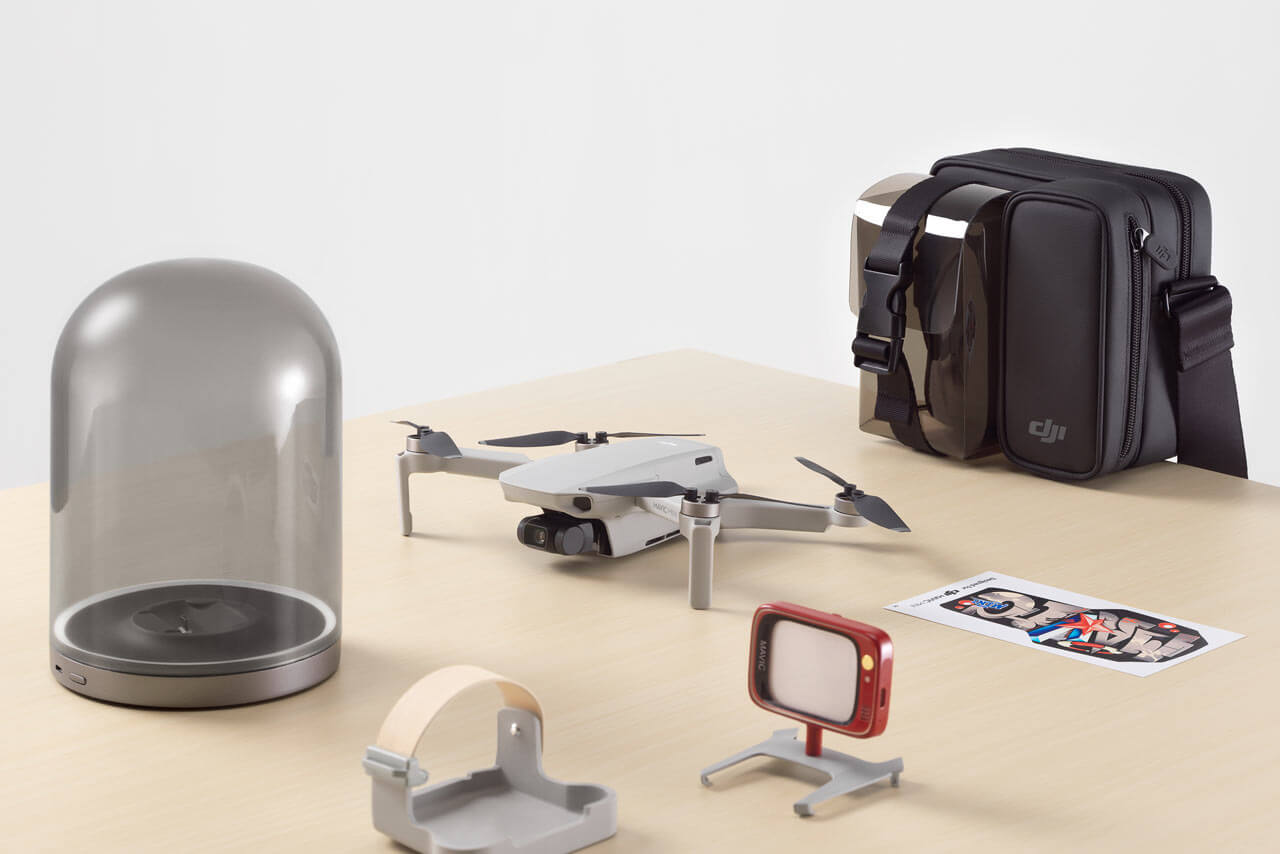
If you opted for the basic package, the two-way smart charging hub is available separately. It can be used to store and transport up to three batteries whilst charging them in sequence (charging the least discharged battery first), unattended and can even be used as a battery bank to charge other devices (but not daisy-chain when it is being charged). The unit also supports fast charging with the optional 18W wall adaptor and is in our opinion it is a must buy for the drone.
The snap adaptor kit features a four-legged clip that snaps on top of the drone with a plastic peg sticking out the top for attaching items. It includes a small retro-TV looking backlit dry-wipe board (and pens for writing on it) as well as a Lego-compatible mount for attaching lightweight Lego figures to the top of the drone. A clear domed charging base is also available, albeit without a wall charger. It displays the Mavic Mini in vertical orientation whilst charging (with a ring light) via a breakaway magnetic Micro-USB adapter connects to the base to charge it up.
Lastly as you might have seen in the launch videos, a DIY creative kit contains stickers (some of which are pre-printed with designs to fill in) and colouring pens to customise your drone as you see fit.
Who is the Mavic Mini for?
We feel the Mavic Mini is best suited for holiday makers looking for a drone to (responsibly) use on trips, or just those using a drone for pleasure, such as taking ‘dronies’ in the garden for their Instagram feed. The included camera is more than up to the job of holiday snaps/videos whilst the intelligent flight modes make capturing slick clips a breeze.

If you are looking for a professional drone for aerial imaging or surveying, you may as well buy the Mavic 2 Pro/Mavic 2 Zoom or Inpsire 2, since you will likely be qualifying for your license, registering with the CAA and applying for a PfCO anyway.
In conclusion
So after a couple of weeks flying this little drone around, here are our closing thoughts:
We love
- Flight Time : 30 minutes from such a small-capacity cell is incredible
- Small size : Finally a truly pocket-sized drone that can survive in our pockets (thanks to its folding design) and travel everywhere with us.
- Registration-free : Lowering the entry point for casual drone users whilst retaining GPS geo-fencing to limit incorrect use.
- Price : Regardless of any faults listed below, the value for money is fantastic, this is a capable, high-quality drone, not a toy.
We dislike
- No Active track : with some of the object tracking it feels like it is powerful enough to do it, but we understand why it was omitted.
- Battery expense : Considering they are just a pair of 18650 batteries with a small controller board, they are heavily overpriced.
- No 24p : A minor gripe, but it would be a valueable tool for many amateur film-makers if it supported this frame rate.
- Lacks fast charging : 2 hours to charge a battery (without using the battery hub) is pretty poor in 2019!
Where can I buy the Mavic Mini?
You can pick up the DJI Mavic Mini from our webstore today, where it includes free next-day mainland-uk delivery. As ever, with its extra batteries, case and charging hub the fly more combo is the smart purchase, should you be able to stretch to it.
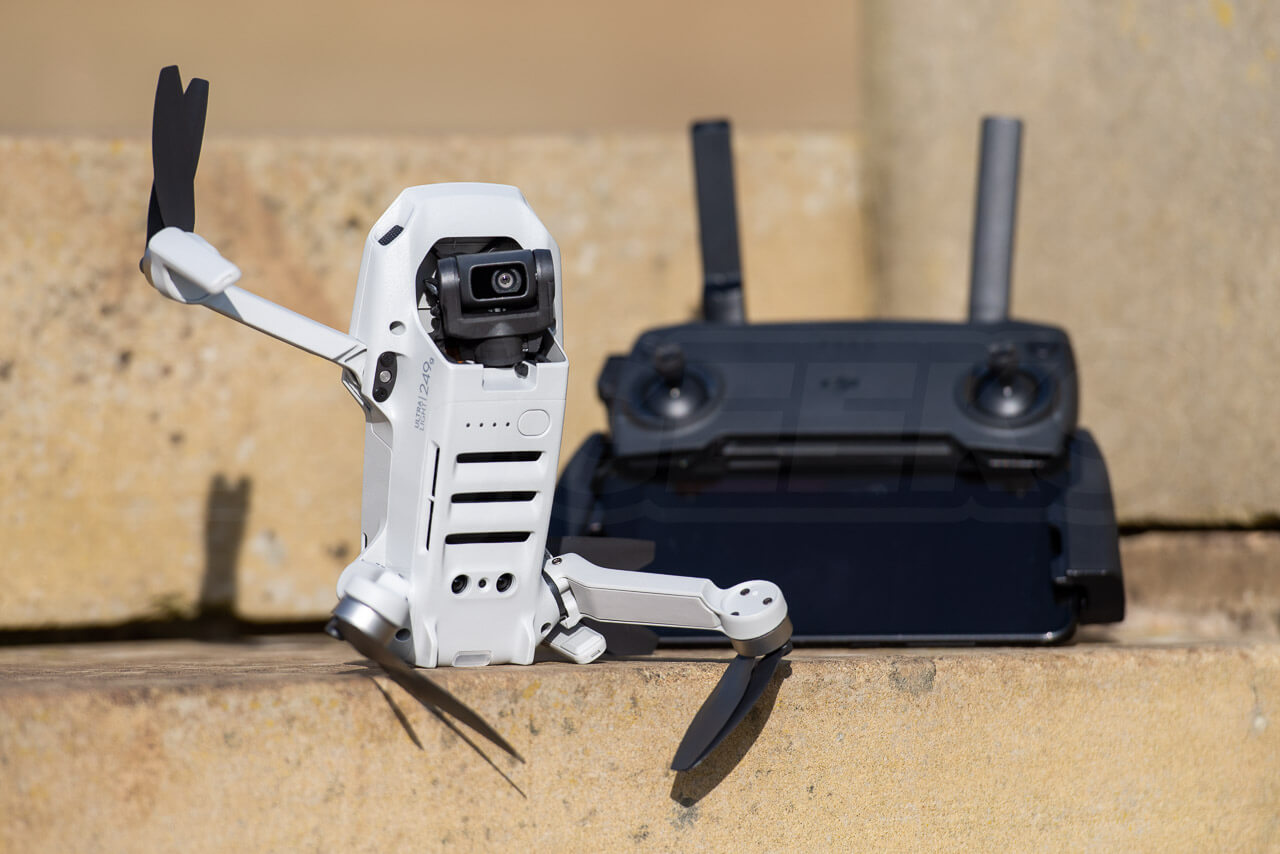
Keep an eye on our DJI manufacturer page where we will list the Mavic Mini accessories and potentially filters when available.
RC Geeks – DJI Drone devotees
We have been DJI stockists since the original DJI Phantom released back in 2013, as such we know their drones and stabilisers inside out. We have extensive reviews on products such as DJI’s Mavic 2, DJI Spark and DJI Phantoms. Browse these articles and more on our blog site.

Do you have any questions regarding the DJI Mavic Mini? Perhaps you have bought one and want to share your experiences? Leave your comments in the section below!

